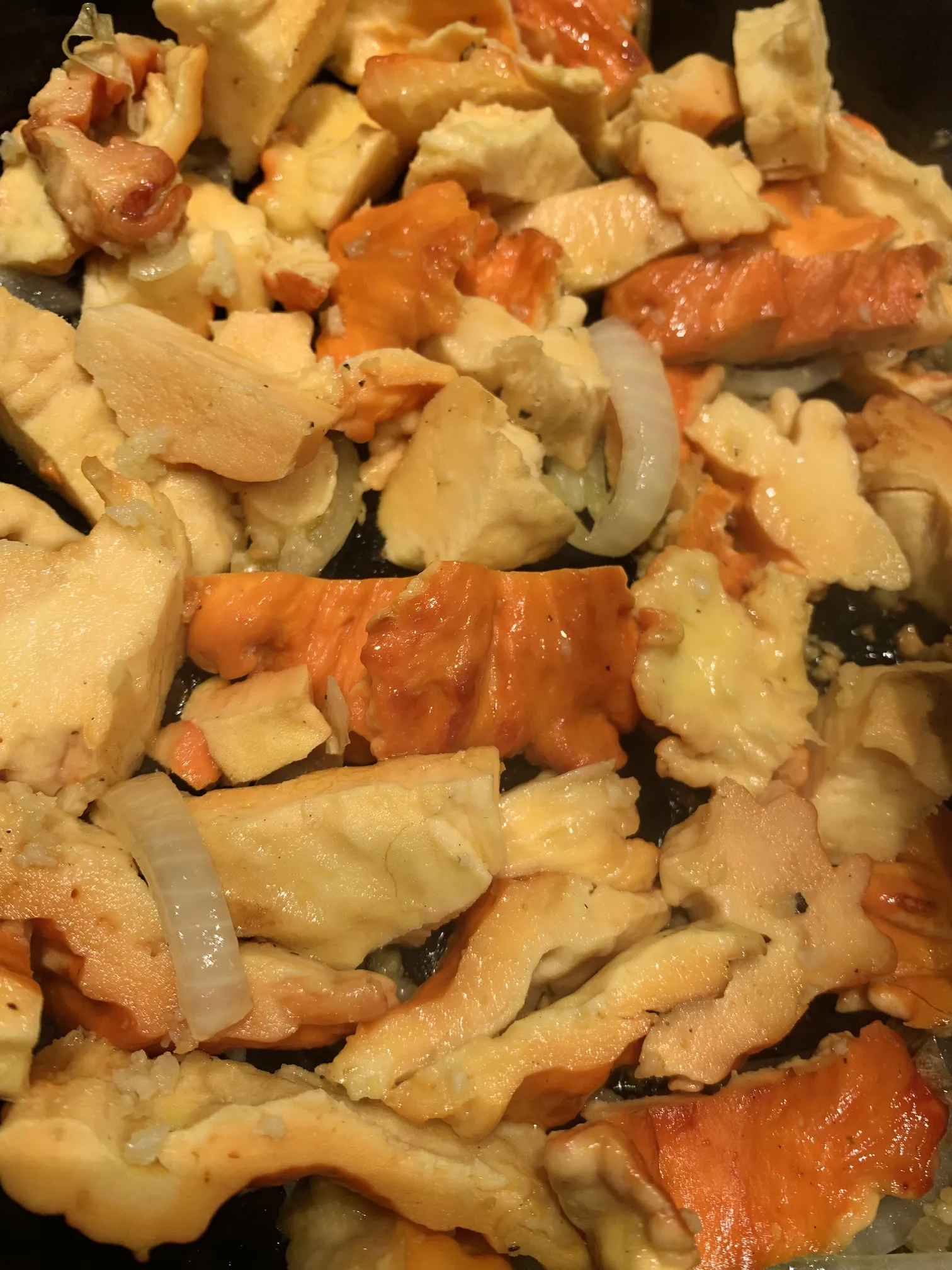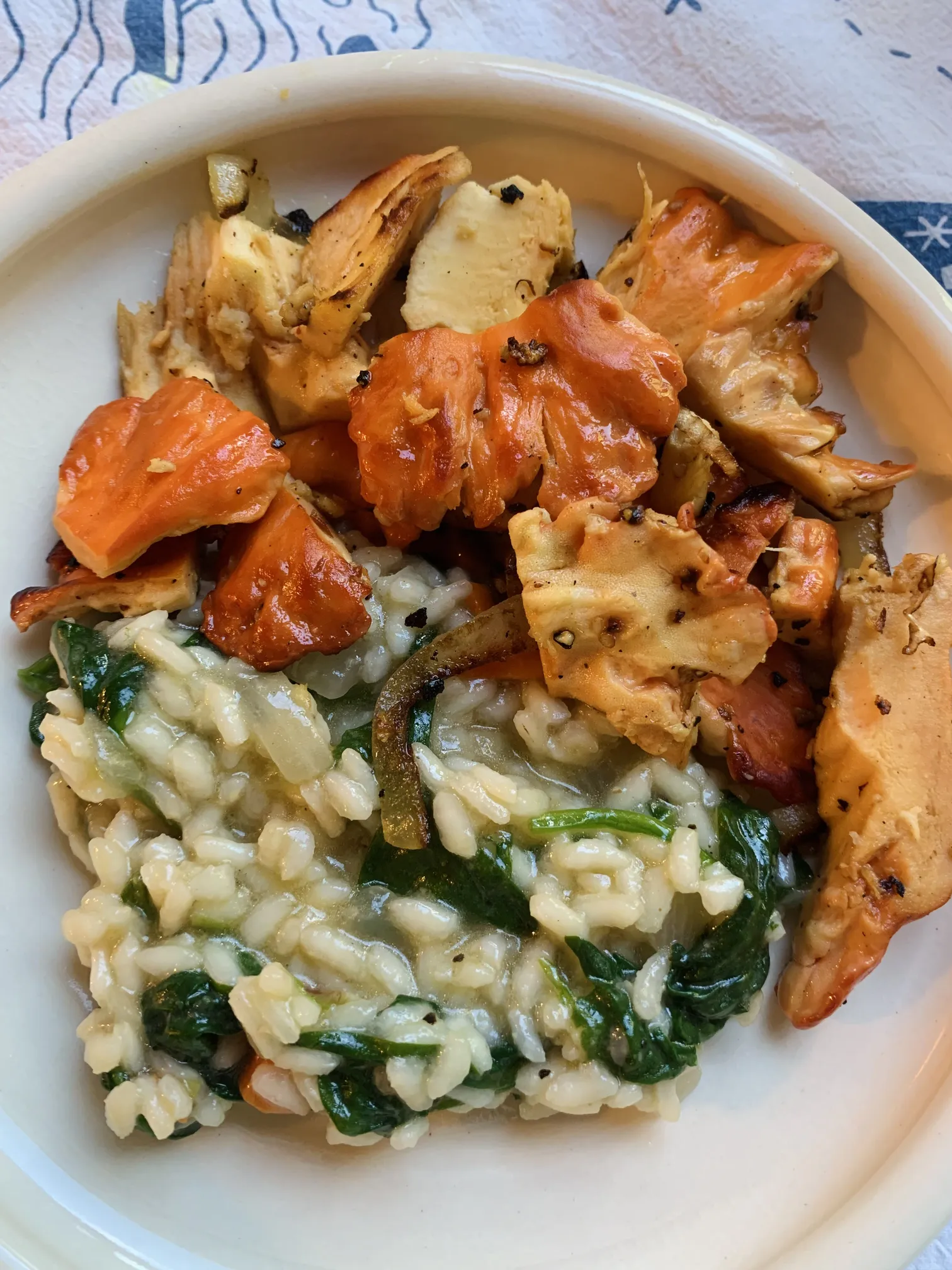io's journal
6 September 2025 - On tinned fish
Tinned fish became a staple food for me when I lived in Kazakhstan, a land-locked country with a meat-based local diet and very limited plant sources of protein. (Someday, I'll document my multi-week quest to find chickpeas!) Upon returning to the US, I discovered that my new fixation was very 'on trend', with every boutique grocery store now prominently advertising 'tinned fish' and bespoke $13 cans of trout with red chimichurri.
I suspect I'm not the only one raised by parents who developed an aversion to the cans after a childhood of soggy tuna salad sandwiches, and resolved to end the generational cycle of trauma themselves by keeping the cans out of the pantry. In light of this, the can becomes an appealing relic of the past, forgotten with the new millenium's fresh-food cult.
There are a few shiny tinned fish cookbooks available, but devoting too much time to any recipe goes against the whole ethos of the tin. Why not just cook the fish yourself if you're going to the trouble of carmelizing onions? Thus, I here intend to share some of my favorite methodologies for eating tinned fish: the salad, the onigiri, and the cracker. These ideas are endlessly customizable to your energy and circumstances and personal palate.
_result.webp)
First, an herring salad. These wild herring fillets with cracked pepper are packed in water and are absolutely massive. I find them an ideal 'salad fish', and you can put whatever you want in your salad... I have mixed greens, red onions, carrot and radish slices, and some sunflower seeds for the necessary crunch. I didn't have it here, but another favorite is sliced red cabbage! The dressing is mustard-based, which pairs nicely with the fish. I mix yogurt, mustard, and red wine vinegar in equal ratios, and then add salt and pepper to taste. If it's too mustardy, add honey or more yogurt. Personally, I love mustard so I'll eat it by itself...
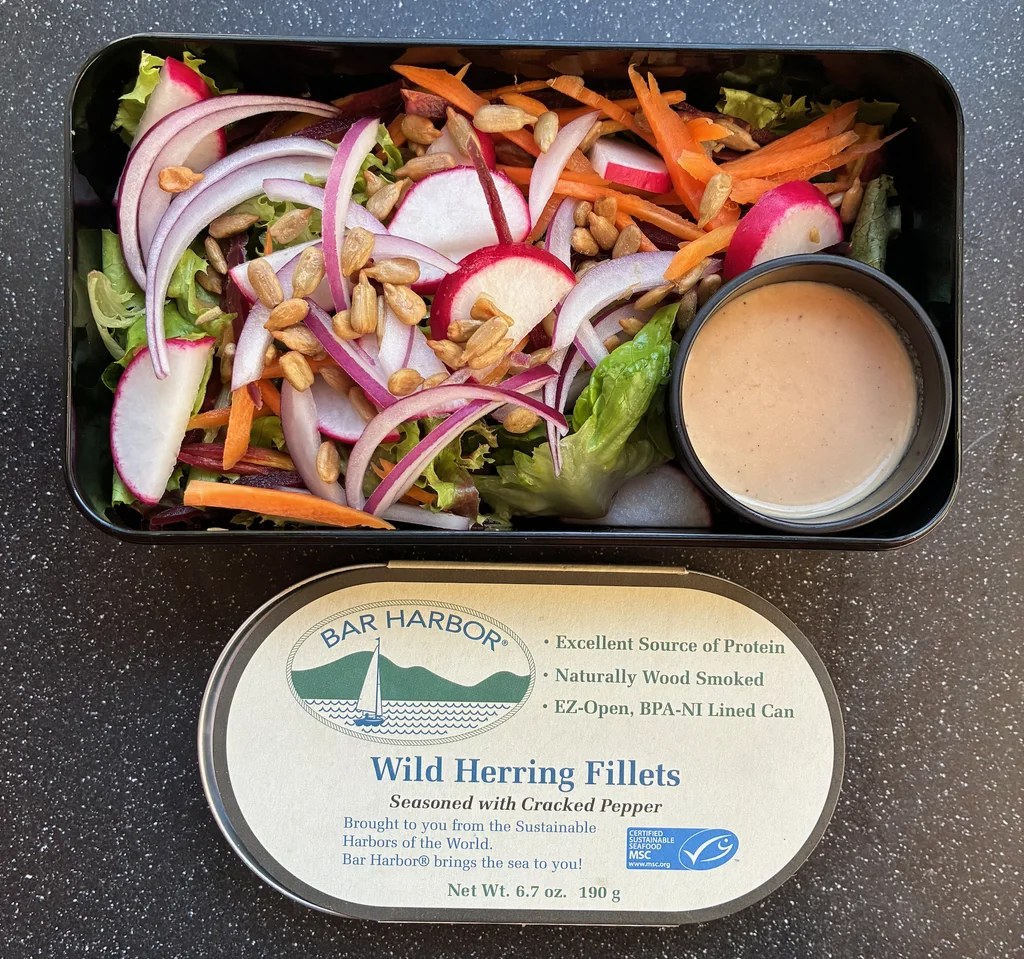
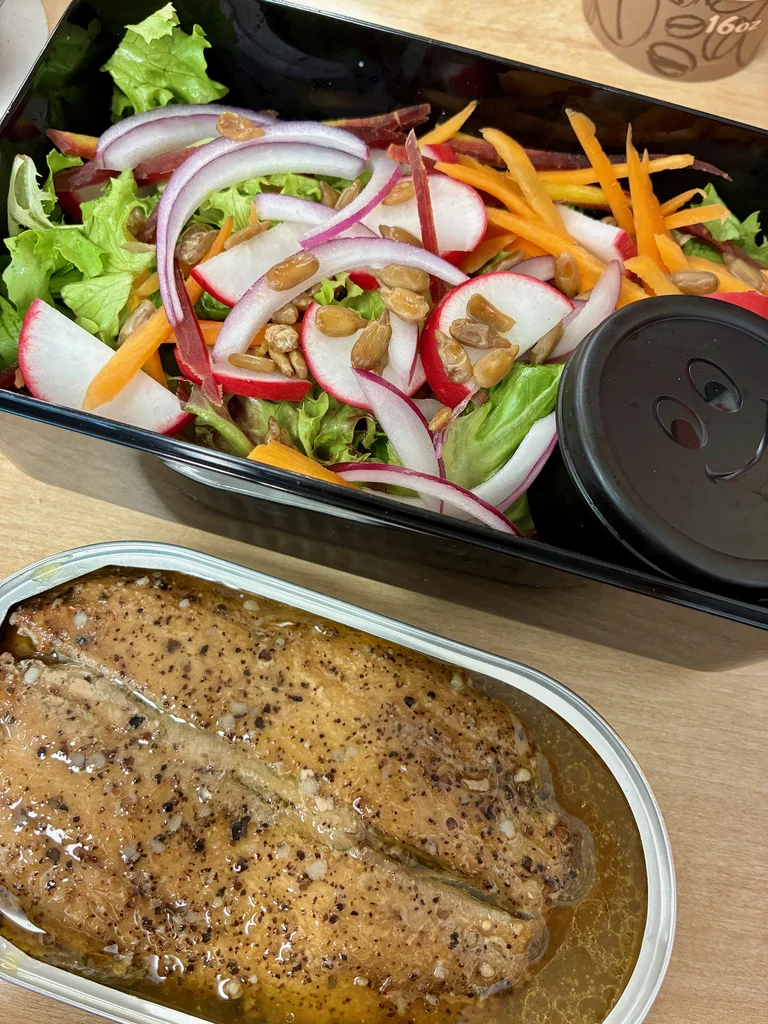
The second is onigiri, but this could just as easily been made as 'rice with tuna salad' if you don't want to bother with the moulds. There's an offensive (or beautiful?) combination of cuisines with the filling, which is a mixture of soy sauce, gochujang, mayo, and Bumble Bee tuna. I like gochujang, so the mixture is more heavy on that than the mayo, but the mayo's a necessary binder here. (Any spicy paste would be good in the filling- sriracha or chili crisp would also be swell!)
I had it with cucumbers, which I slathered with doubanjiang to make a uniquely unphotographable meal. I want to say something self-aware about my mixing of cuisines, but I also want to say that it's delightful to live in a world where we can pick and choose from so many rich traditions and mash them all together with a plastic fork. :-)
_result.webp)
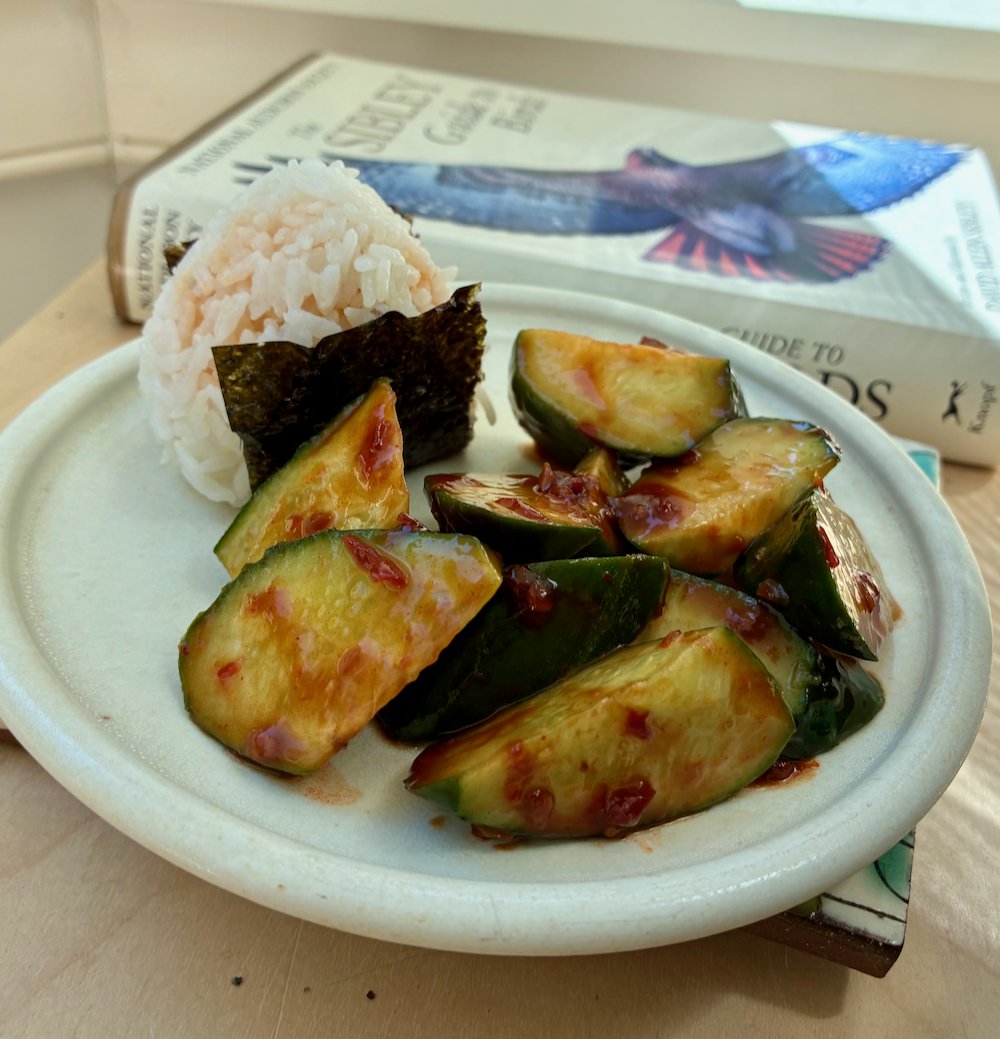
The final, and most versatile (or simple), methodology is the toast-cracker-crostini. I find it fun to experiment with all sorts of relishes and flavor combinations- for whatever reason, some fish just seem born for specific pairings, like sardines are made for tomatoes and salmons (?) are made for capers. It's kind of beautiful, actually; it's a very lowbrow version of wine pairings.
_result.webp)
For educational purposes, here are a sampling of random combinations of fish, toppings, and vehicles I've tried and enjoyed. My biggest recommendation are the alshark Moroccan sardines- I've been able to get them for $2 a tin at various halal and African markets, and they are quite yummy for the price! I also am rather fond of the trout from Trader Joe's, and my favorite mackerel that I've tried is by far the King Oscars. They are all at reasonable price points, and both the trout and the mackerel seem to be great 'gateway fish' for the people who don't enjoy crunching on little sardine spines (which I love).
(I have an irrational belief that the more unappetizing a food is, the more nutrients it must secretly hold, which has led to me eating fish eyes. My bloodwork is sublime, so my theory may hold some water.)
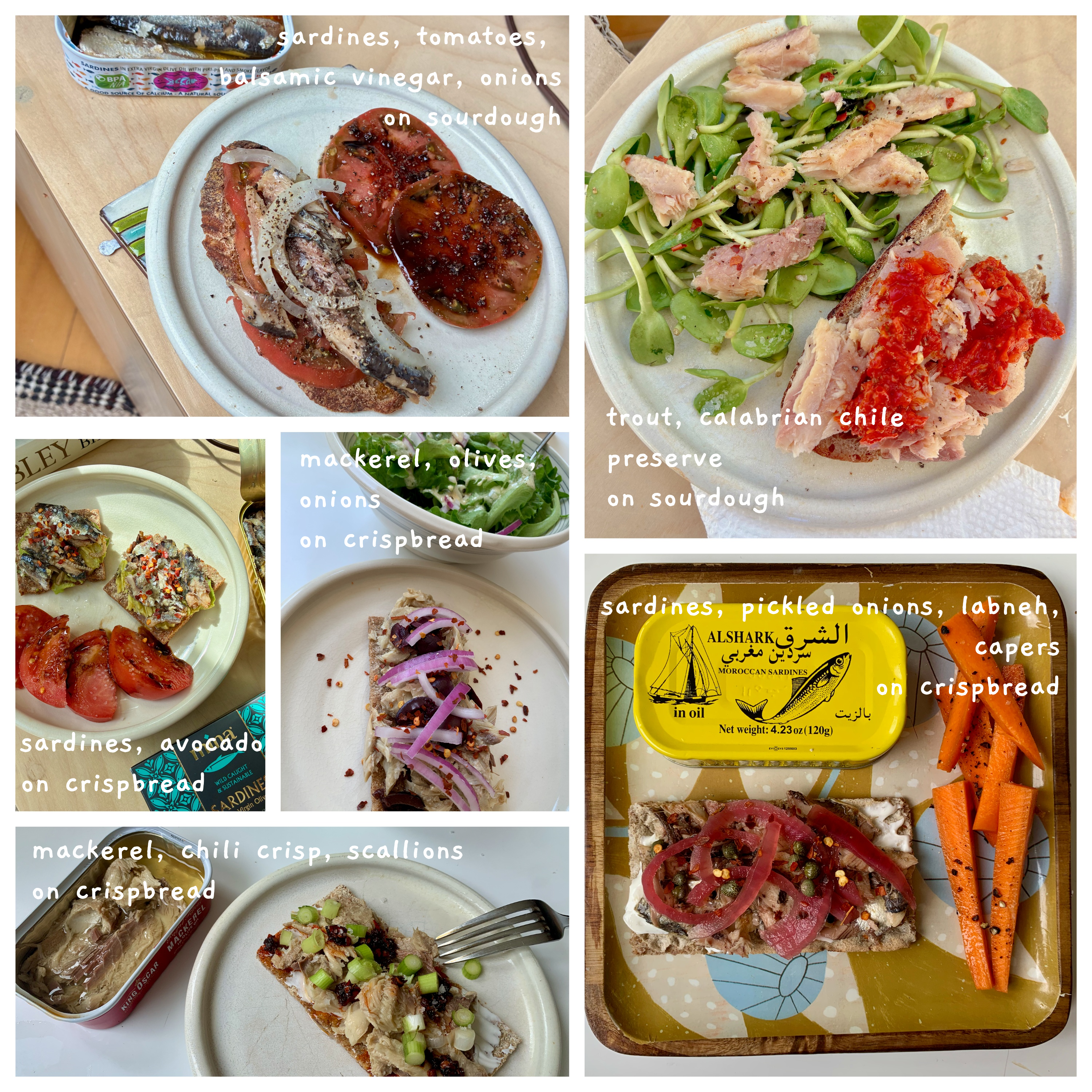
6 July 2025 - A foray into pickles
I wrote after my trip to Japan that my interest had been piqued by the role played by pickles, or tsukemono, in Japanese cuisine; I've always loved how food preservation reflects the peculiarites of a region, its traditions and environment, and after ordering an embarrassing number of books about pickles, fueled by temptingly low prices on AbeBooks, I've filled my refrigerator with a range of experiments.
The first several recipes I made are from Machiko Tateno's 'Japanese Pickled Vegetables', though I have yet to tackle the more traditional Japanese pickles she mentions using a rice bran pickling bed. I started, instead, with a very not-Japanese pickle, white kimchi. (Kimchi is hugely popular in Japan, I learned to my suprise, but the Japanese take on kimchi, sometimes called kimuchi, is much less spicy and not fermented as long as Korean kimchi. It almost veers on the sweet. I ate buckets of the stuff during my time in Tokyo.)
Tateno's recipe for white kimchi has you use apples to provide the sugar rather than relying on added sugar. It turned out beautifully (I think!) with a rainbow of carrots, daikon, napa cabbage, cucumber, and apple... this is considered a "summer dish" given how refreshing it is, equal parts sour and sweet. I'd like to follow a Korean recipe for white kimchi next.
The other two pickles in the first photo are from the same book, one made from Napa cabbage core with sichuan peppercorns and then miso-cured daikon. The miso-cured daikon tastes basically just like miso, so I wonder what you'd typically eat it with.
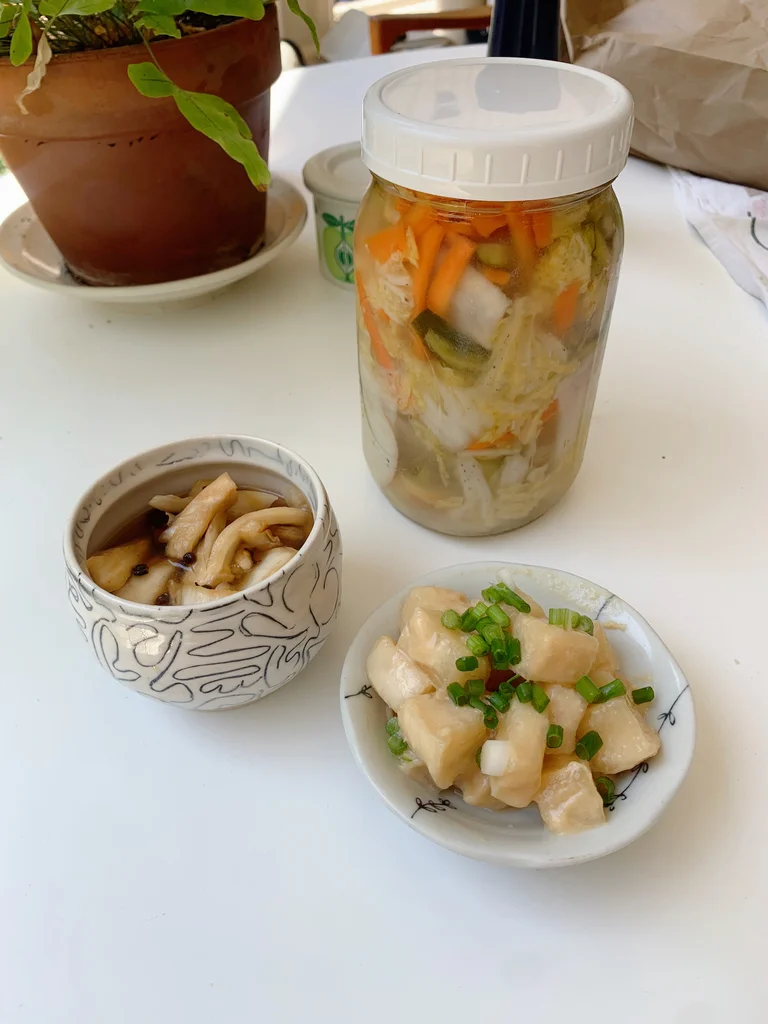
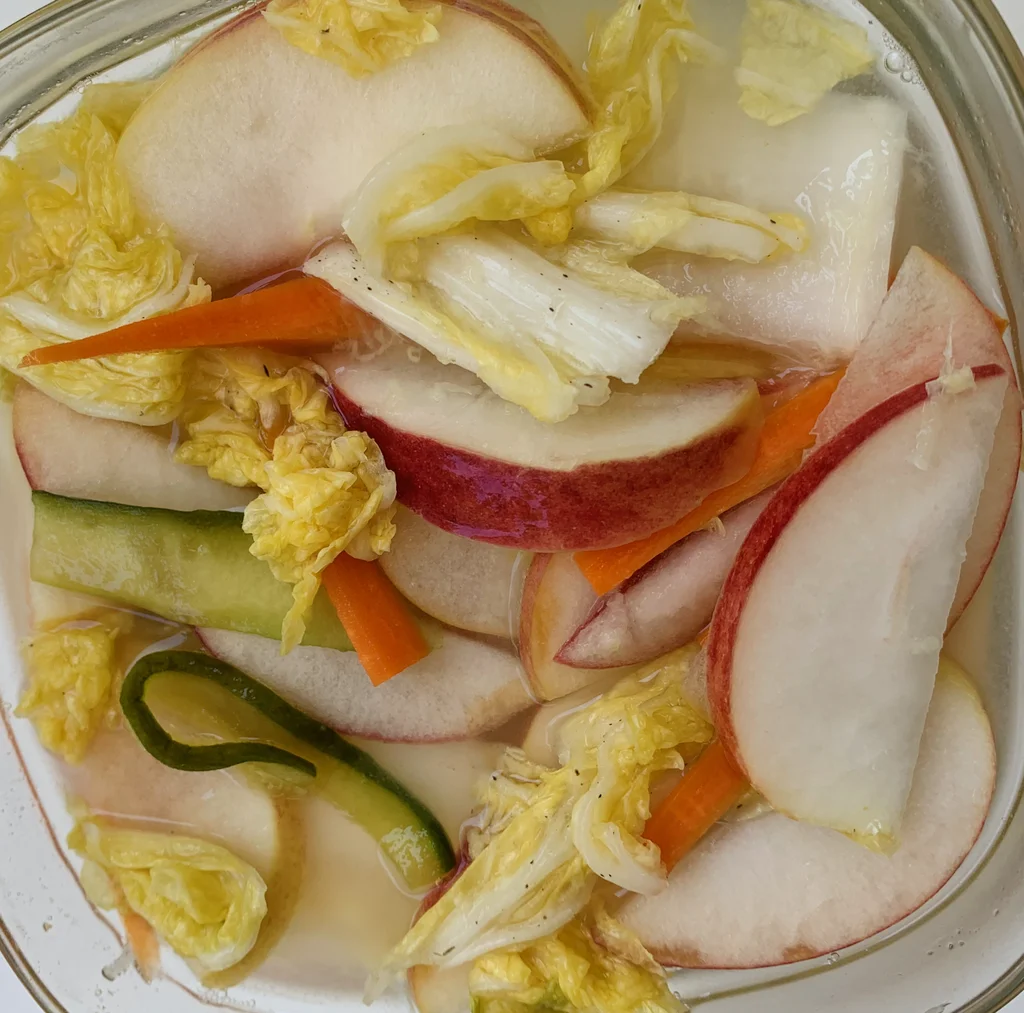
Next, a quick pickle from carrot and daikon, and then these crunchy cucumber pickles which have you repeatedly boil the cucumbers in a soy sauce brine, something I'd never done before that results in an extremely crunchy pickle! The carrot-daikon quick pickle ended up inside of a tofu banh mi and would complement any sandwich well.
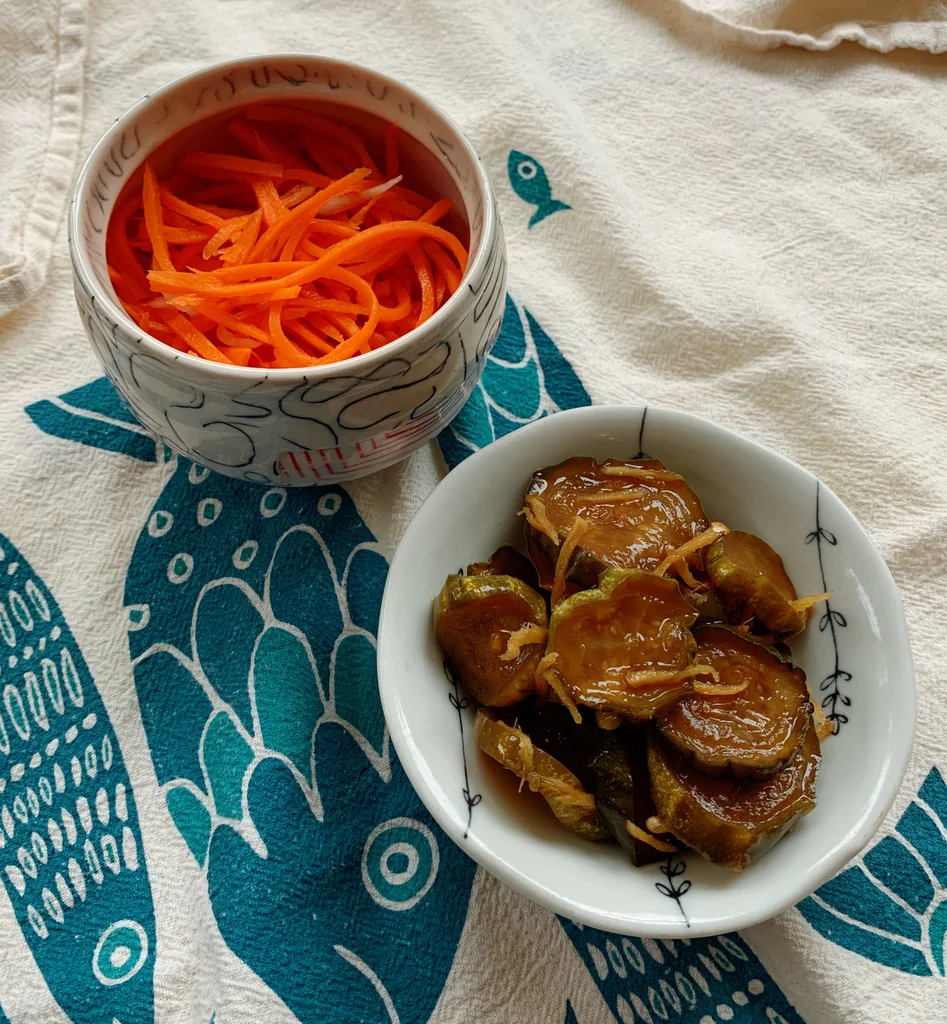
The next morning I tackled two heads of cabbage- one head of Napa cabbage and one head of green cabbage. The green cabbage I fermented following a recipe from 'The Joy of Pickling' by Linda Ziedrich for "kraut chi", an interesting synthesis of sauerkraut and kimchi that ferments green cabbage with ginger, garlic, and red pepper. (If you're curious how sauerkraut and kimchi differ other than by spices, sauerkraut is usually pounded and crushed before being packed for fermentation. This breaks down the cell walls, releasing the brine. Kimchi doesn't endure as much abuse. In addition, preparing kimchi involves the preparation of a rich, flavorful paste from scallions, garlic, ginger, red pepper, anchovies, and rice starch, which is then slathered on the cabbage.)
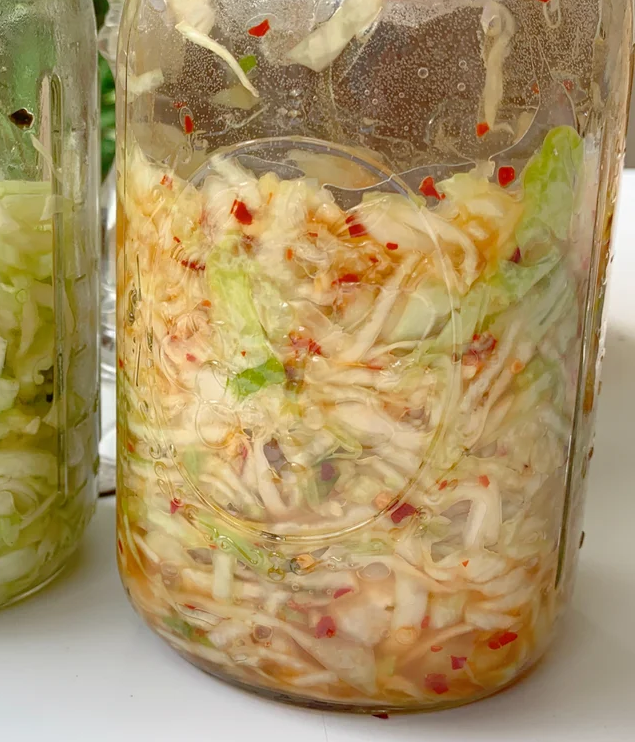
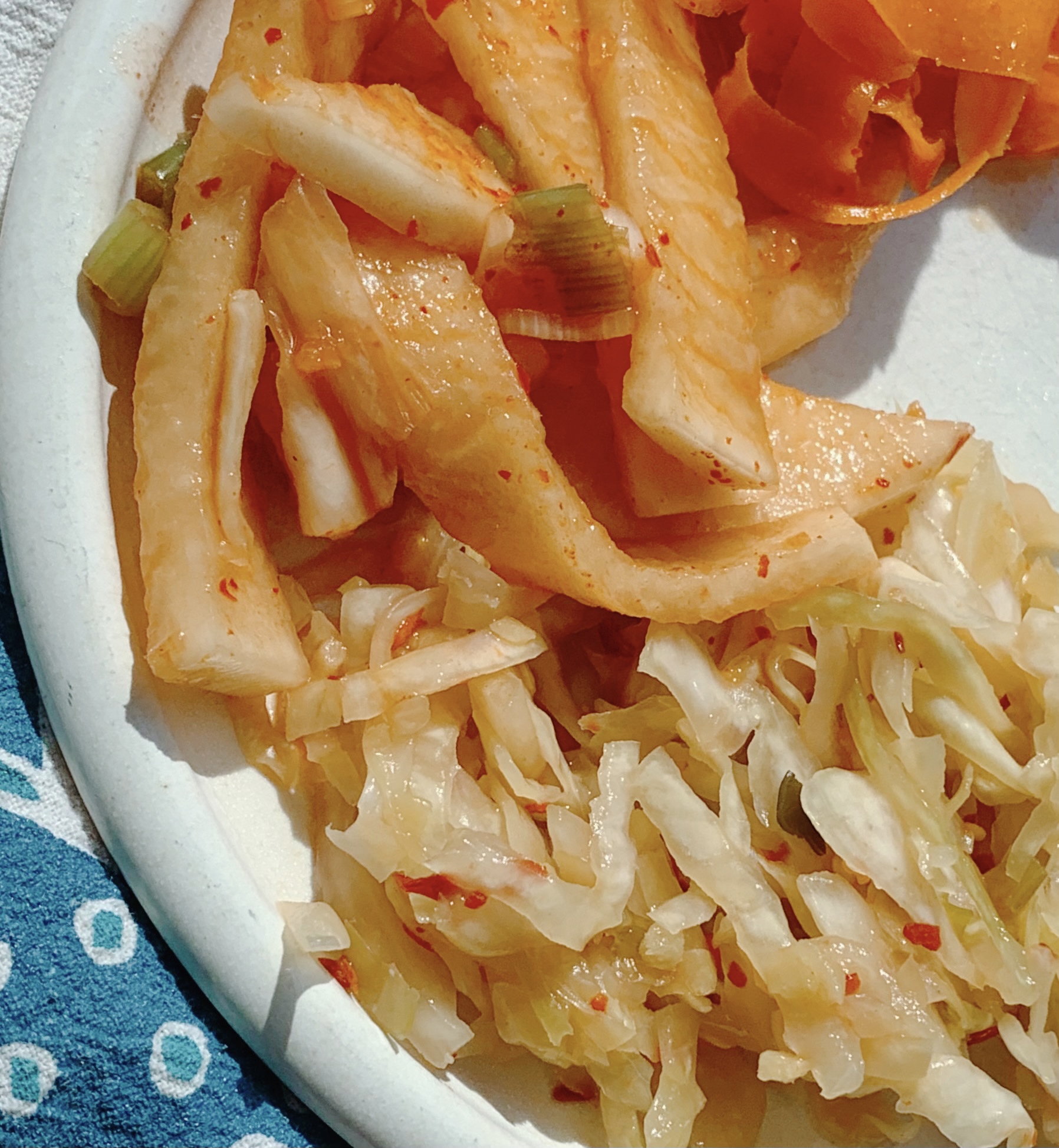
The kimchi recipe is from 'Asian Pickles' by Karen Solomon. I didn't use anchovies or fermented shrimp, but next time I'd like to follow Maangchi's recipe for baechu-kimchi and use either. The process of making kimchi is tremendously therapeutic, I think, I was really surprised by how much fun it was to just coat my hands in red paste and go ham slathering the cabbage. And it's so fucking good!!!!
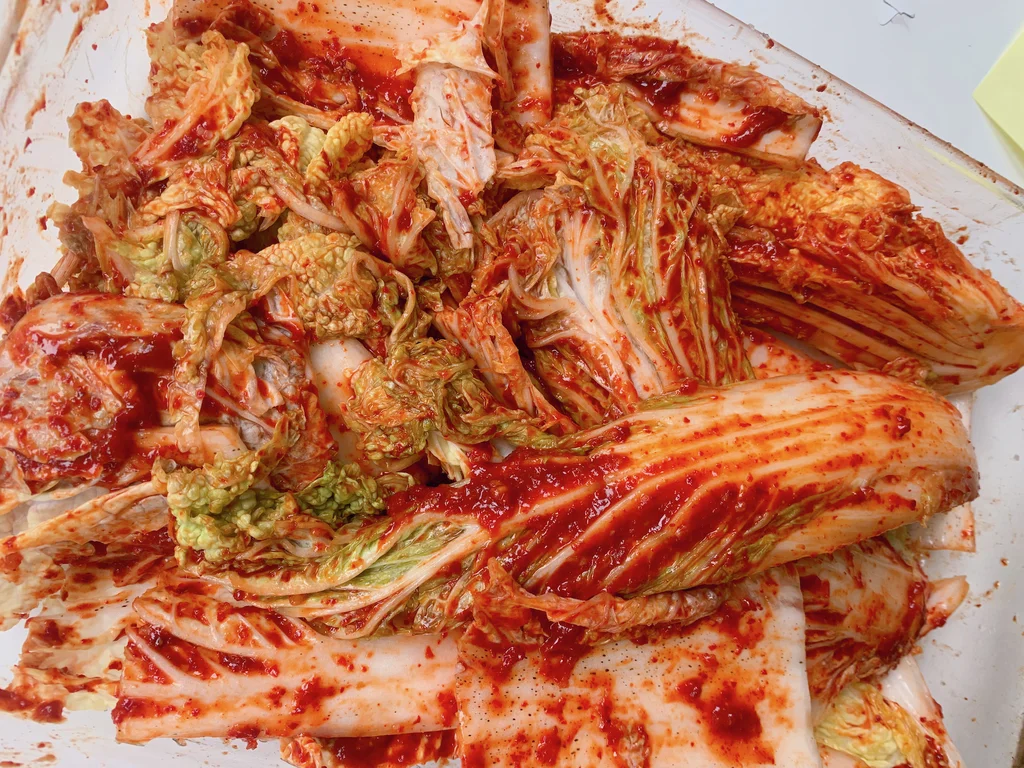
I visited the kimchi museum when I was in Seoul and I'd like to consider myself a sort of kimchi devotee. One of my favorite breakfasts is kimchi with eggs and gochujang, and I also made a recipe for seared tofu with kimchi this time. The jar disappeared quickly...
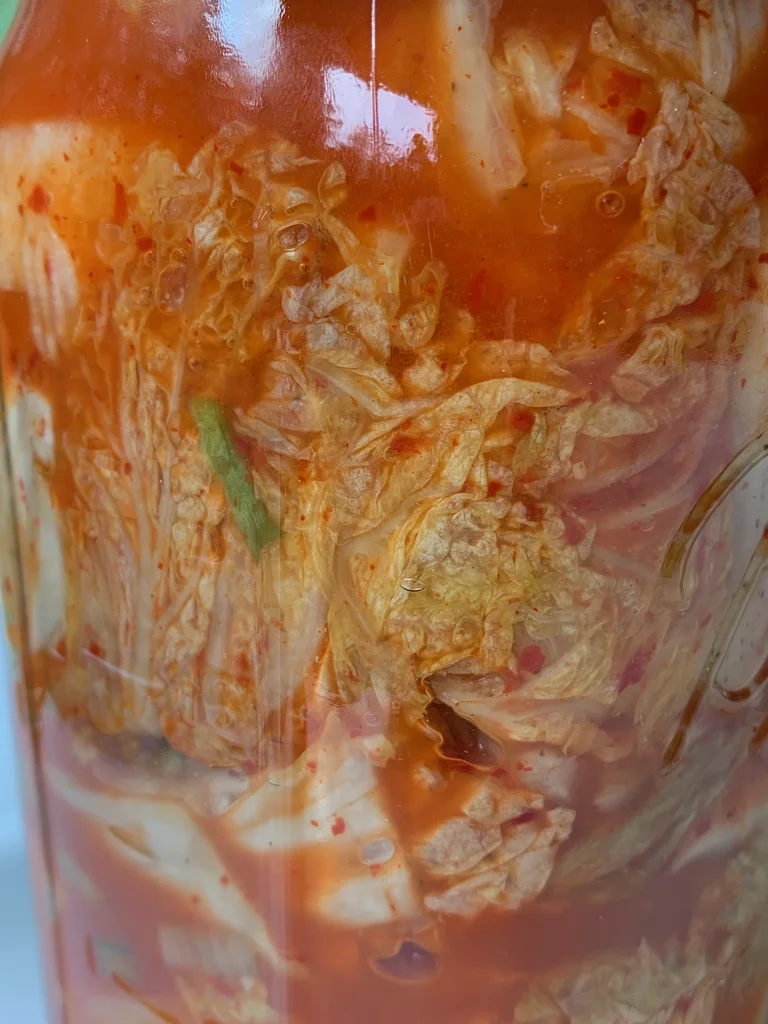
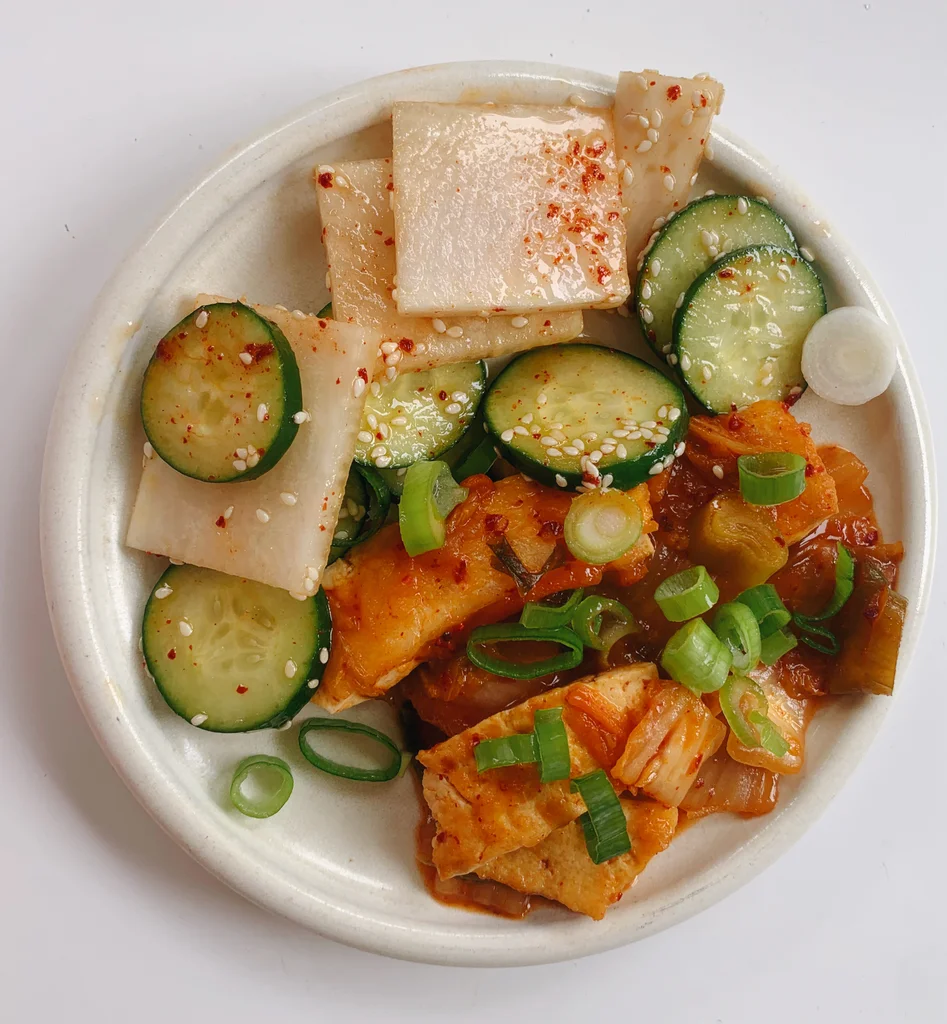
I actually have several other pickle experiments to document but I worry that I'll never finish this post if I go into detail on each, so I'll end here with these red onion pickles I made from this recipe. They're essentially boiled and steeped in a laundry list of spices- black peppercorns, allspice, star anise, cinnamon, bay leaves, dried red chile, and cloves, plus some Sichuan peppercorns I added for the hell of it. This results in an almost sweet, intensely flavored onion which is good with pretty much anything.
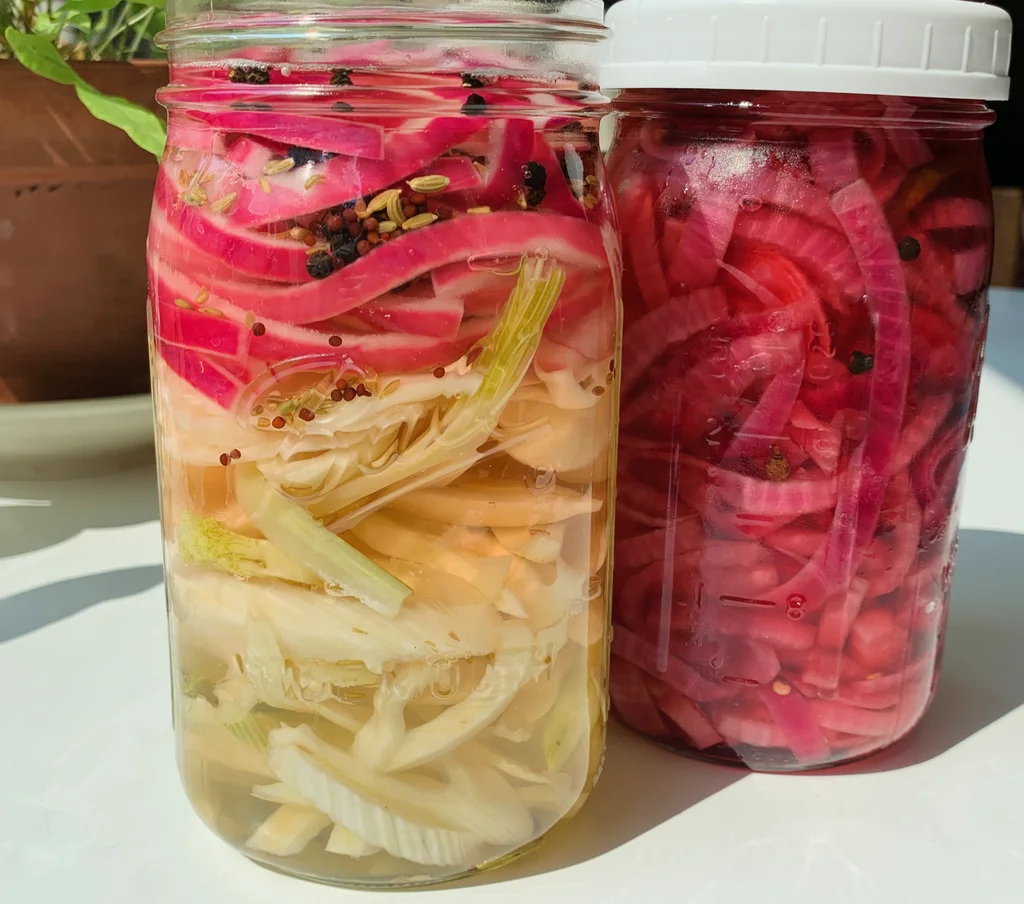
11 May 2025 - Designer drinks
A pipe dream of mine is to open my own cafe where I serve specialty coffee drinks from different countries. Each country has its own set of menu staples which never manage to cross the border. In Kazakhstan, Kyrgyzstan, and Georgia this is the Raf (a super-creamy latte-like drink), the bumble (espresso added to fresh-squeezed orange juice), and the espresso tonic (espresso and tonic water). In South Korea there's the Einspänner, which is espresso topped with whipped cream. Greece has the Freddo, foamy espresso served over ice.
There are a few drinks that are much more common in the US, too, with cortados, macchiatos, and dirty chai lattes coming to mind.
.png)
Coffeeshops in Almaty don't stop at the raf and bumble, though, and every menu offers its own section of "avtorskie napitki" - signature drinks? author's drinks?.
I've tried here to compile some particularly notable ones I tried. My favorite among these is the strawberry qurt latte, from Tereze (tereze_ala on instagram). Qurt is a salty, sour, hard dried cheese prepared from fermented milk that occupies a central place in Kazakh consciousness; its long shelf life, nutritional density, and portability made it an ideal snack for a nomadic lifestyle, and it hasn't lost any popularity in the conditions of the city. At the front of every convenience store, alongside the sticks of gum and single cigarettes, is a bowl of qurt for the hungry shopper.
In the latte, its intense saltiness complements the sweetness of the dried strawberries perfectly. Another favorite adaptation of qurt has been the qurt ice cream from Umami (umami_almaty on instagram), which is deliciously creamy and salty and oh-so-good. And there's also chocolate with qurt, from Petit chocolate and coffee (petit_chocolate_coffee).
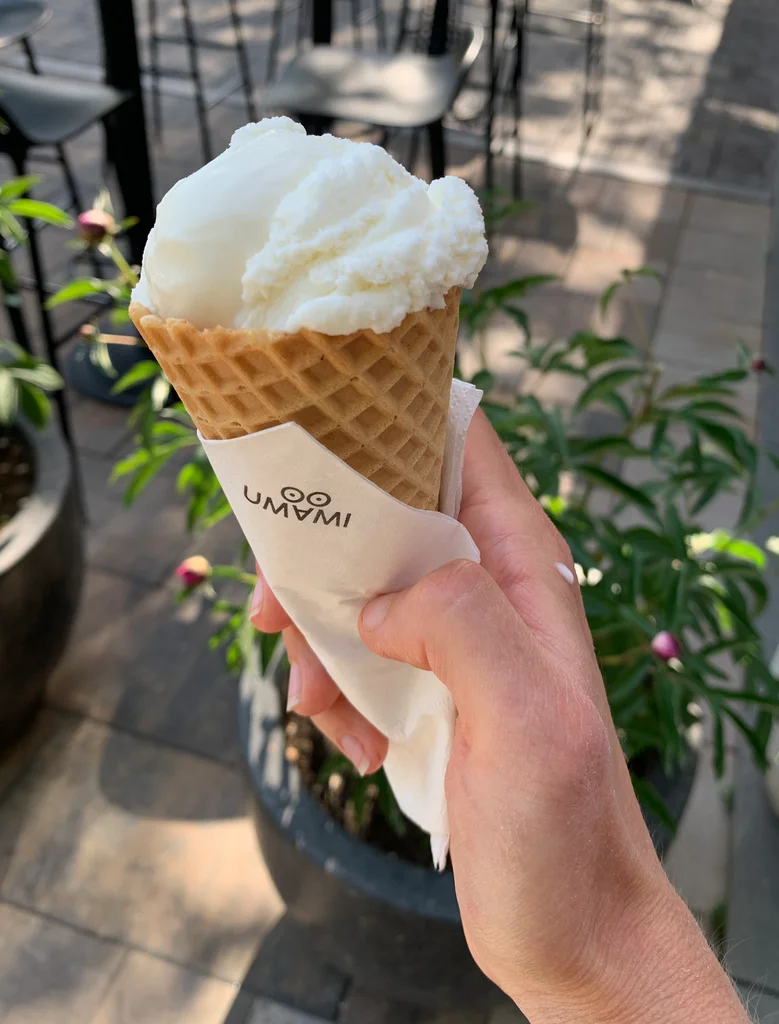
But this blog post was about coffee, right? Another synthesis of traditional Kazakh ingredients with coffee is the roasted millet cappucino. Roasted millet, tary, has a million culinary applications: it's blended into a flour and mixed with honey and butter to make jent, a sweet sort of snack, or alternatively steeped with black tea, boiled with milk to make a porridge, or added to a soup alongside horse meat, barley, corn, and kefir. (Millet is drought-resistant and grows well in hot, dry conditions, making it an ideal grain for the steppe.)
26 April 2025 - Remembrance of DiGiorno's
This journal entry is spurred by a quite comical phenomenon. Recently, I've been craving Digorno frozen pizza, the shitty stuff with the puffy crust that tastes like a half-eaten sub dug out from a dumpster. I haven't eaten it since I was twelve, maybe, and it's something I was only permitted on Tuesdays when my dad got home late from work so the task of making dinner fell to me.
A few weeks ago, I finished volume 1 of Remembrance of Things Past. Being in an acute state of homesickness gives Proust more power- my childhood is on another continent in a different tongue. What has dryly been termed 'the Proust effect', that is, his focus on sensory stimuli as triggers of memory, has put me in a state of mind where I'm constantly finding myself longing pathetically for some American grocery store item. It's the prepackaged food I miss most of all, the kind of thing I haven't touched in a decade, something I could never allow myself to indulge in now (because it's embarassing for an adult to eat Annie's Mac and Cheese, and I don't let myself eat pasta or cheese to begin with!). No romance of the madeleine and the teacup here!
I consider myself a deeply nostalgic person and, perhaps worse, I sincerely believe that my ability to romanticize my own past is a superpower- I treasure the way time sweeps away all of the complexities and pains of the past, I love the signifigance a banal moment takes on in hindsight. I love pining after things I've lost!
23 March 2025 - "Free" food
One of my most prominent traits is that I'm a massive miser. With this in mind, two of my favorite things in the world are airplane meals and hotel breakfasts. While they are by no means free, they are presented in such a way to make you believe that you are getting something wonderful for free.
I'd like to, thus, provide a review of "complementary" meals during my trip to Tokyo and Seoul. There is something wonderful I discovered while trawling through the Asiana Airlines webpage: in the annals of the special meal requests section, on that hidden "other" tab after all of the different dietary restrictions they cater to, there is an option to request a Seafood Meal, presented with the description "for those who prefer seafood". I have absolutely no idea why those of us who Prefer Seafood, in economy class on a budget airline, are awarded the sole privilege of chosing a meal type that no one else is privy to, but I am not complaining. It was a tad funny having the flight attendents hurry up to me on each flight with a little notepad and say "You've requested the special seafood meal, right?" as if I had some medical condition they were taking care to accomodate.
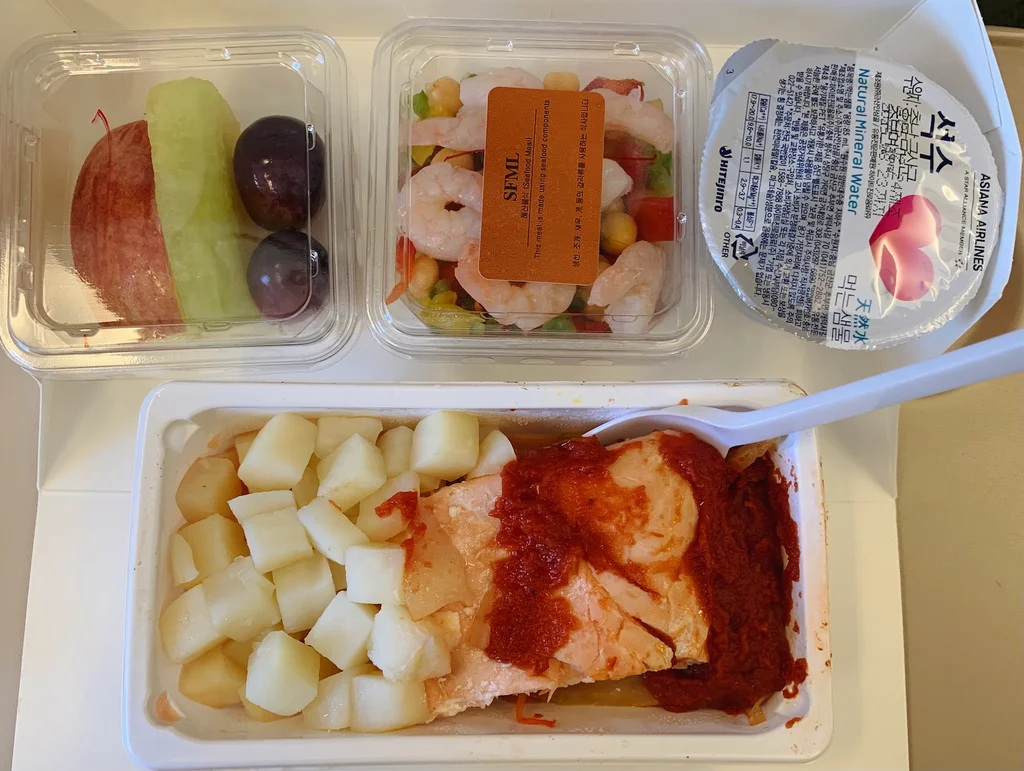
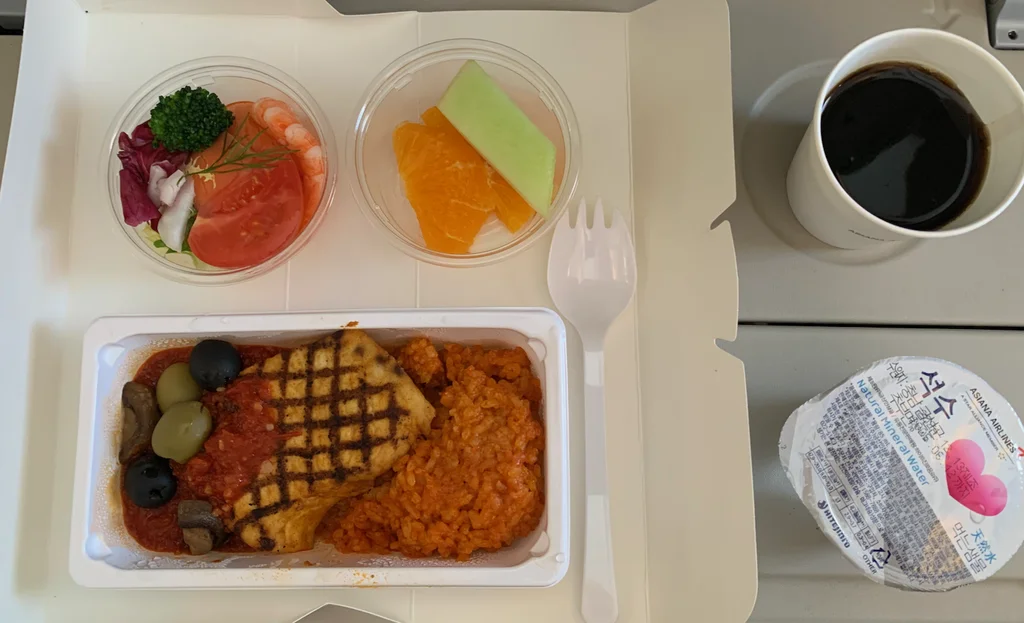
For my ICN-NRT flight I was served grilled salmon with a sauce of carmelized onions, tomato sauce, and potatoes, plus a salad of shrimp and chickpeas. (Yes- even the side dishes include seafood!) A little unseasoned but scrumptious nonetheless.
On the same route in the opposite direction: a grilled white fish with tomato sauce, olives, mushrooms, and rice, plus a cute little salad with shrimp and smoked salmon, for some reason arranged with an artistry Michelin star restaurants aspire to. This one was better (both were very good!). On my final ICN-ALA flight I was served the first meal again, but this time before landing they surprised me with a cute little sandwich with smoked salmon and capers, which was delicious. I'm a fiend for smoked salmon.
Now for the hotel breakfasts: I stayed three nights in a hotel without a breakfast and three in one that did offer a breakfast. I had been really, really looking forward to the opportunity to try natto, so this was a highlight of my trip. In general, it's like a miracle to walk through a buffet of foods you don't recognize, with labels you can't read, and scoop up EVERYTHING you want to try. And every day the breakfast offerings changed! I'd live at this hotel if I could. Please consider sponsoring me, if you'd like.
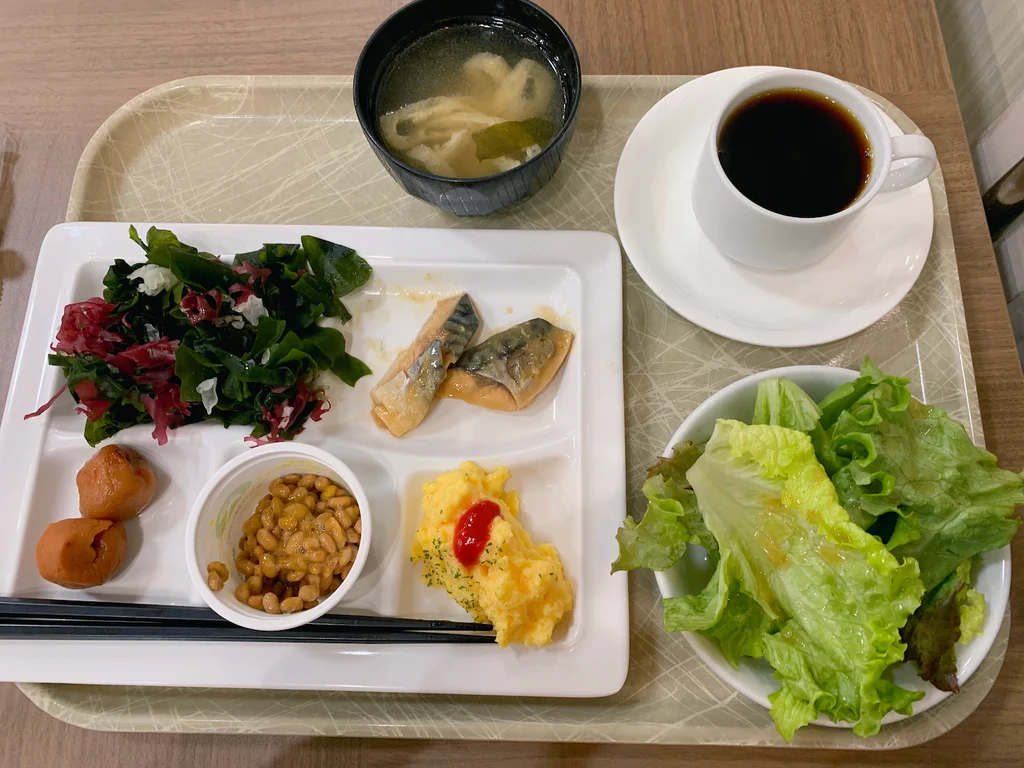
Morning one: natto (!), stewed mackerel, pickled plums, seaweed salad, lettuce, miso soup, and scrambled eggs. And coffee. I was expecting natto to have some ridiculously pungent, remarkable taste, but no, it doesn't taste strongly of much at all. Not bad and something I'd like to add to my breakfasts more often. The mackerel was really yummy, and I think I had mackerel for every meal for two days in a row. I often think about how little of the spectrum of any cuisine is imported abroad: that is, when we think of Japanese food in the US, we think of sushi, ramen, then if you fancy yourself a "Japanophile" perhaps tempura, udon, onigiri, curry, or soba, but things like oden and saikoyaki don't even enter our consciousness. This condensation and popularization is necessary, I guess, but it's a shame (and gives one more reason to travel the world to sample the full offerings of any cuisine).
What I'm saying is that mackerel is really good. And saikyoyaki is really good. The pickled plums, though, were awful, though, and I rarely react to food with such vitriol.
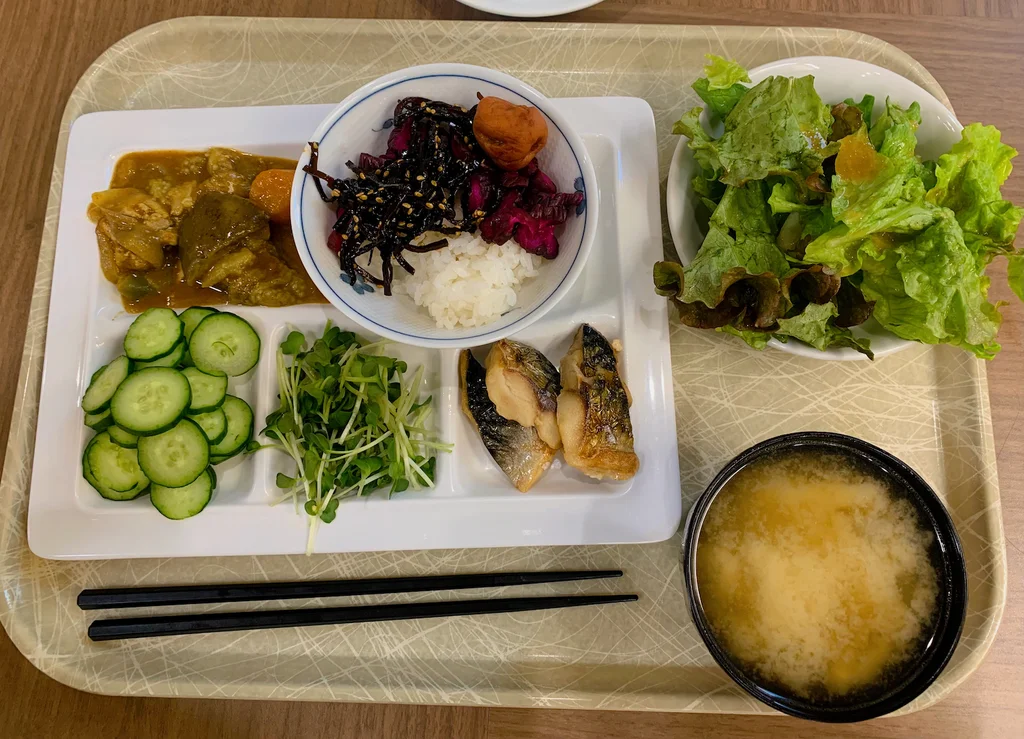
Morning two: curry, grilled mackerel, bean sprouts, cucumber slices, miso soup, and lettuce again. Mackerel continues to delight. I saw that people were putting the pickles... purple pickles? and seaweed and plums on rice so I tried that. The pickles are good. Plums still awful.
(I looked up 'purple Japanese pickles' afterwards and learned that they are shibazuke, a specialty of Kyoto that is colored by purple perilla leaves! They are pickled with ginger and plum vinegar as well. And usually eaten with steamed rice, similarly to other Japanese pickles. I had not at all been appreciating the beauty and diversity of Japanese pickling culture. I said this before, but the breadth and beauty of world fermentation and preservation traditions never ceases to inspire me!!!!! It's so cool!!!! I want to open a fermentation specialty store.)
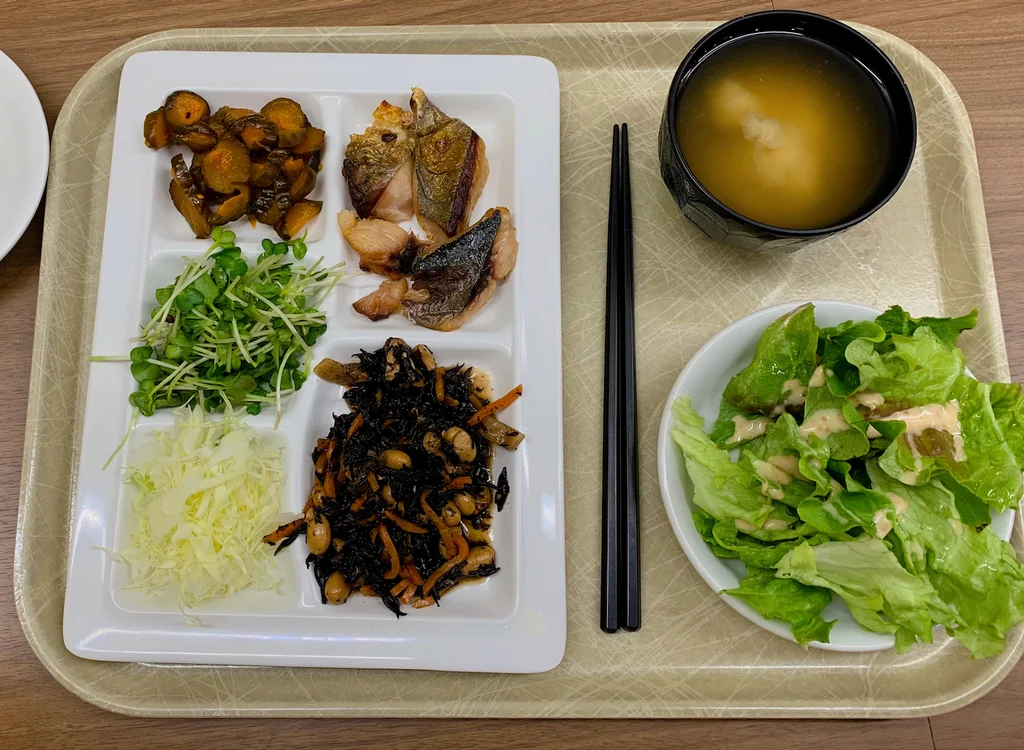
Morning three: sadness at breakfast ending. Grilled mackerel, pickles, bean sprouts, cabbage, and some dish without a label- it's like seaweed, carrots, and soybeans, perhaps? It was good, a little sweet. Pickles are not purple but red this time. If you know what they're pickled with to color them like this, please let me know!! And miso soup again of course.
I feel compelled to end this with some appeal to the reader to let me know what your favorite airline meal or hotel breakfast has been. I think Asiana Airlines occupies the number one spot for me. (If you work for Asiana Airlines, maybe you feel like giving me a free ticket thanks to this advertising?)
10 January 2025 - A curious spread
It turns out it's very easy to fall out of a habit! Hopefully this year I manage to update this journal a little more regularly. I wanted to write about a spread which has intrigued me.

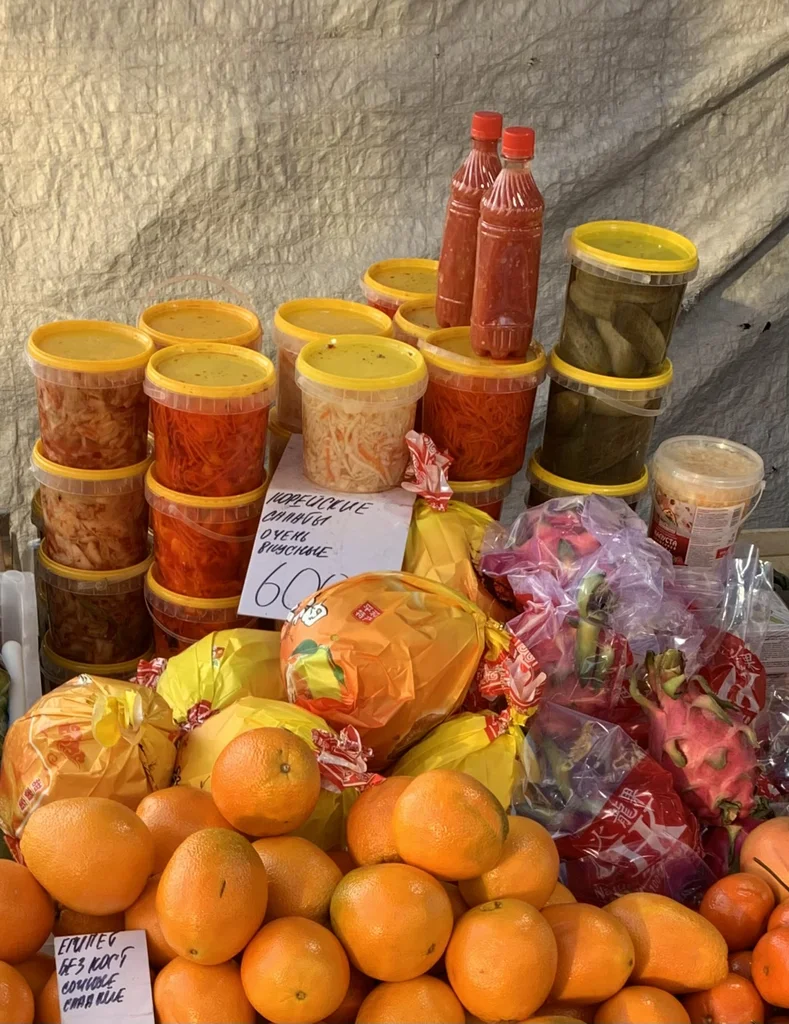
Walking around Almaty in the winter, you'll notice at every fruit seller a collection of plastic tubs filled with various pickles and salads. One tub will hold pickled cabbage, one tub will hold pickled cucumbers, and one will hold chimchi, which is already interesting- it's the version of kimchi brought by Koryo-saram, ethnic Koreans living in Central Asia. It's made with different types of peppers (not gochu-garu), doesn't use fish paste, and isn't fermented as long, having more of a salty-garlicky than a sour-fishy-spicy taste. (Of course, there's a million ways to make both dishes- I'm grossly generalizing.)
Alongside these big tubs will invariably be a few plastic bottles filled with a red spread called kobra. I have discovered, thanks to a jar of the stuff delivered by a friend's relative, that it goes with absolutely everything- eggs, manti, cabbage, buckwheat, straight out of the jar- it's spicy and garlicky and horseradish-y and I have trouble not dumping it on everything I eat.
The strange name adds to its allure, and made me determined to find out where the dish originated. My understanding, now, is that it's a local adaptation of what is called in Siberia khrenovina, which is usually based on tomatoes, horseradish, garlic, and red pepper (both sweet bell pepper and spicy red peppers). Kobra is also sometimes called a form of adjika, the Georgian sauce, which is similarly based on red peppers but has a bit of a different consistency, often includes walnuts, and uses spices characteristic for Georgian cooking (coriander and blue fenugreek). At the same time, kobra is also reminiscent of ajvar, the Balkan condiment made of bell peppers and eggplants.
All in all, kobra exists on a splendid red sauce continuum spreading across Eurasia, each reflecting local tastes and ingredient availability in their own region, resulting in a lovely rainbow of sauces. Somewhere they add walnuts, somewhere they add eggplant, somewhere it's spicy, somewhere it's sweet... and rather than being primarily bought already vacuum-sealed in a sterile jar, each sauce is made by a relative with their own winning recipe, reflecting their own predisposition to add too much garlic. The one commonality between these sauces is that they're invariably made from a bumper crop in the summer and then packed away in jars and enjoyed throughout the winter.
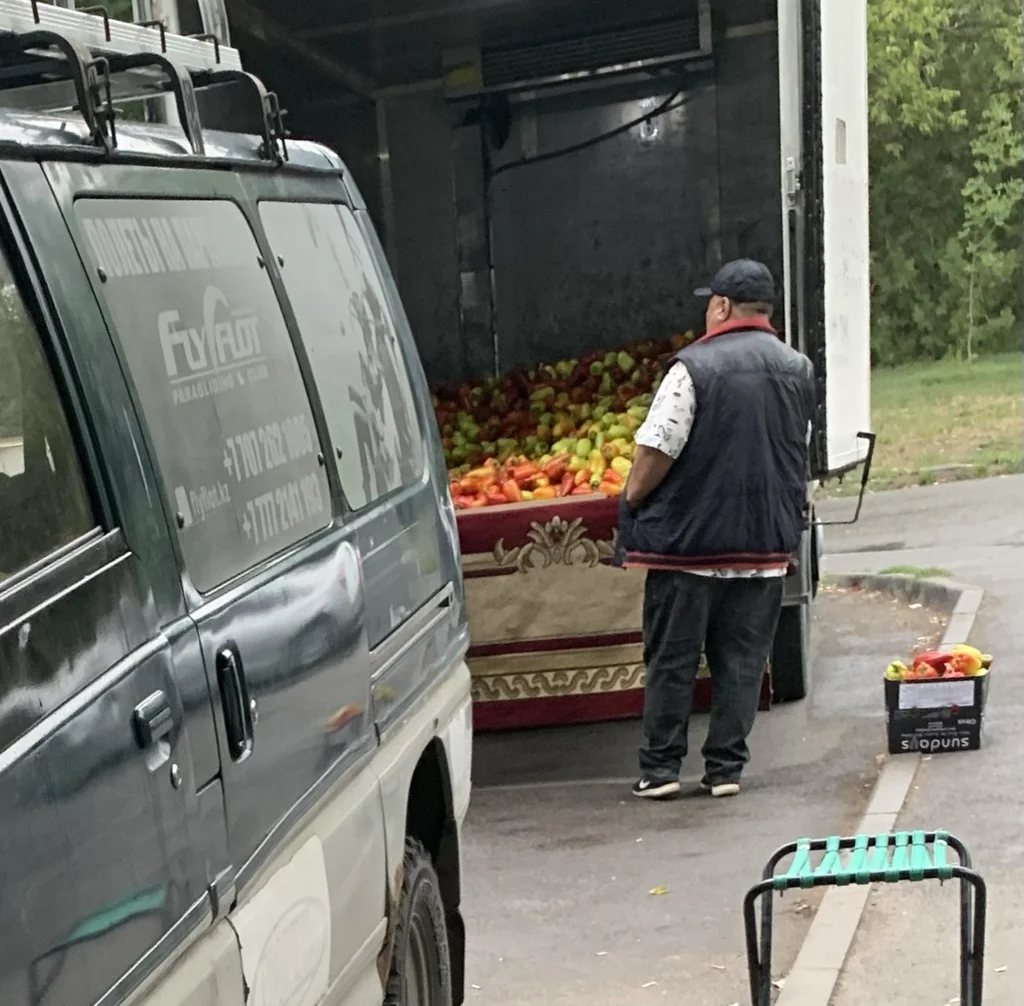
But in a city of 2 million, where people live in apartment complexes and don't keep their own gardens, how is this maintained? Where's everyone getting their bumper crop of peppers from? The answer's simple: in September, someone will pull up to your apartment complex with a moving truck bursting with peppers.
22 September 2024 - Late summer
Hi! I've been busy settling back into life in Almaty and getting used to my class schedule. I want to describe this time of year here as best I can for those of you who have never been, could not dream of going, and may be challeneged to find Kazakhstan on a map.
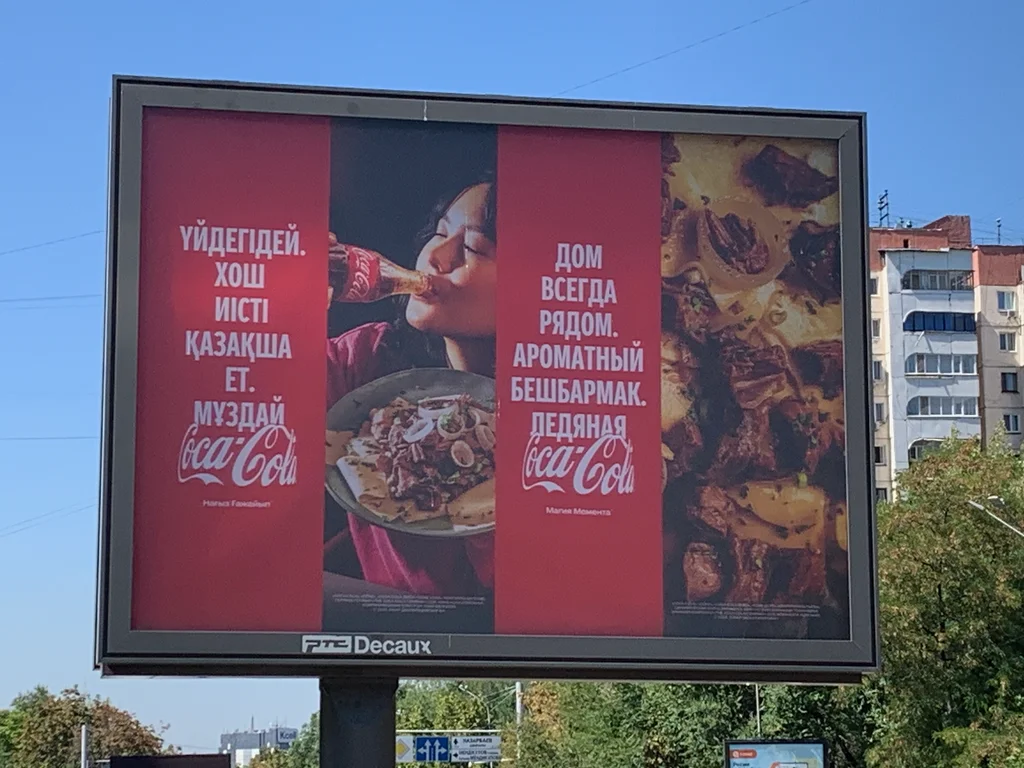
This ad for Coca-Cola reads, in Kazakh on the left and Russian on the right, 'Home is always close by. Fragrant qazaqsha et. Icy Coca-Cola.'
Qazaqsha et, or beshbarmak as it's called in Russian, is the most traditional Kazakh dish, ususally made from large, flat noodles boiled with horse meat and sparsely dressed with onions and dill. The juxtaposition of such a storied dish deeply rooted in the local conditions with the international sterility of Coca-Cola was a little funny and speaks to the simultaneous worship of the past and sprint into a shiny commodity future you see here.
As a side note, Lay's released beshbarmak flavored chips in 2022. I tried them and found them not bad.
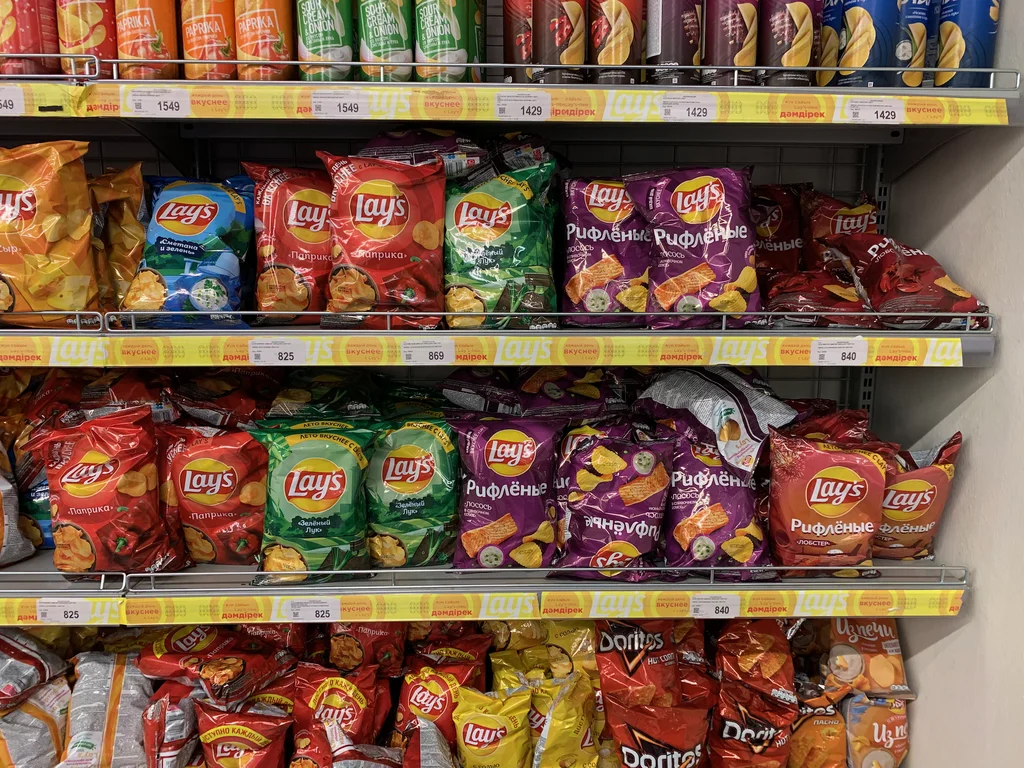
Speaking of Lay's, you might be interested to know that some of the most popular potato chip flavors in Kazakhstan are crab, lobster, and salmon. All three are, as might expect from a landlocked country, extremely expensive delicacies (actually, I find it hard to believe you could find lobster in Almaty for less than its weight in gold).
I worked as a grocery store cashier in Maine and sold a lot of lobster, crab, salmon, and Lay's chips, but had never considered the possibility of seafood-flavored chips. I figure their popularity has to be a direct result of the mystery of their source flavors: we always want what we can't have, I guess.
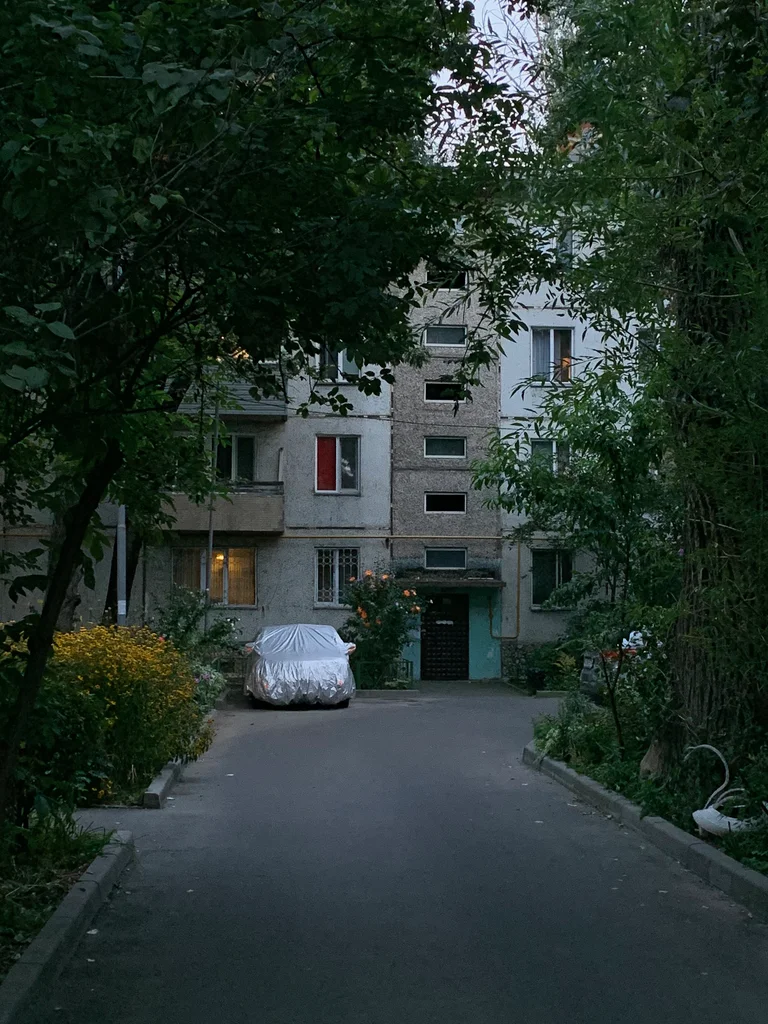
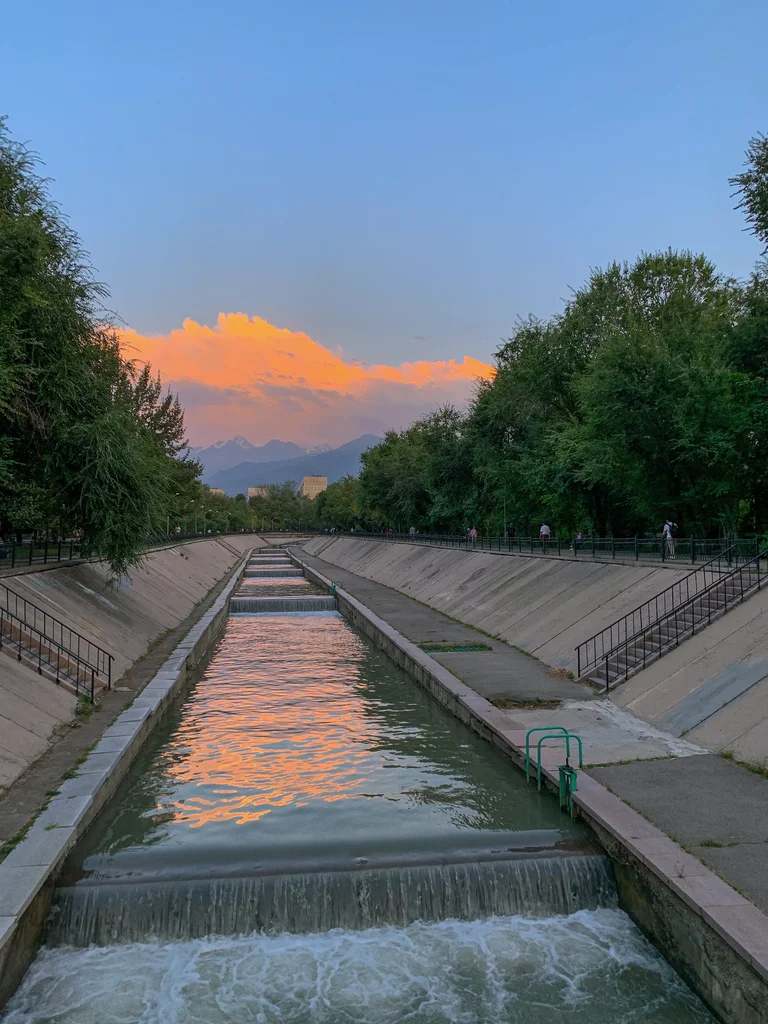
The mountains rise up behind every building and serve some sort of poetic purpose. They always look a little different: particularly sharp after rain, dusted with snow, shrouded in fog... each time, I think I'll be able to capture their beauty with my phone, but it's totally impossible. I'd like to try shooting them with a telephoto lens or something.
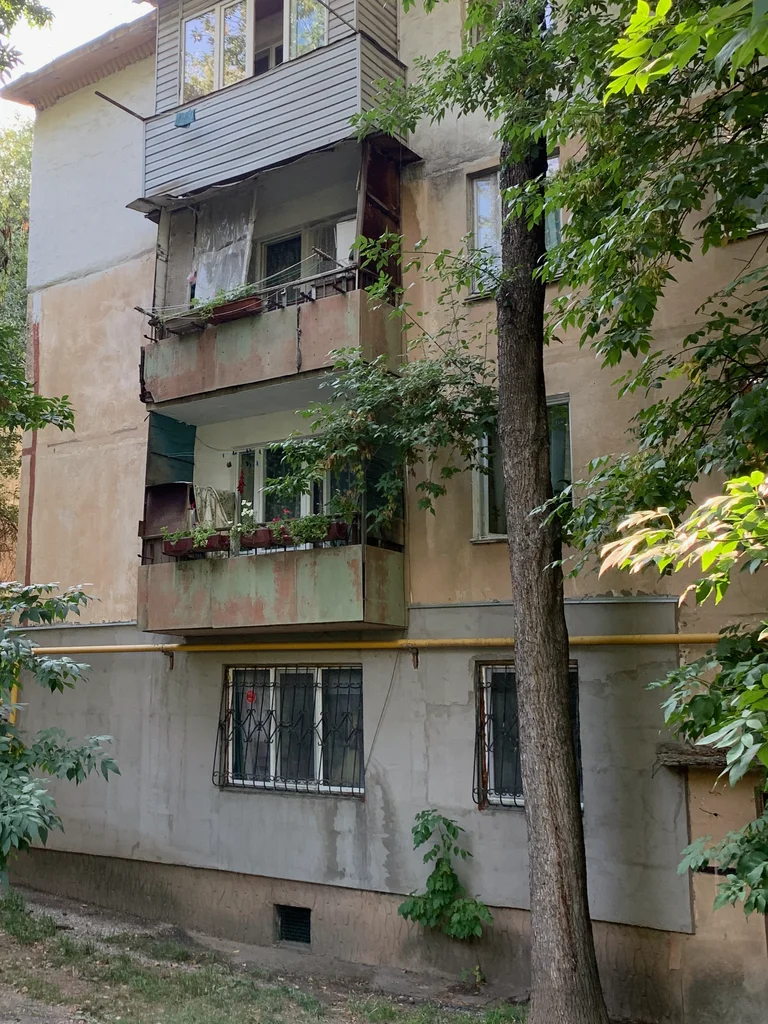
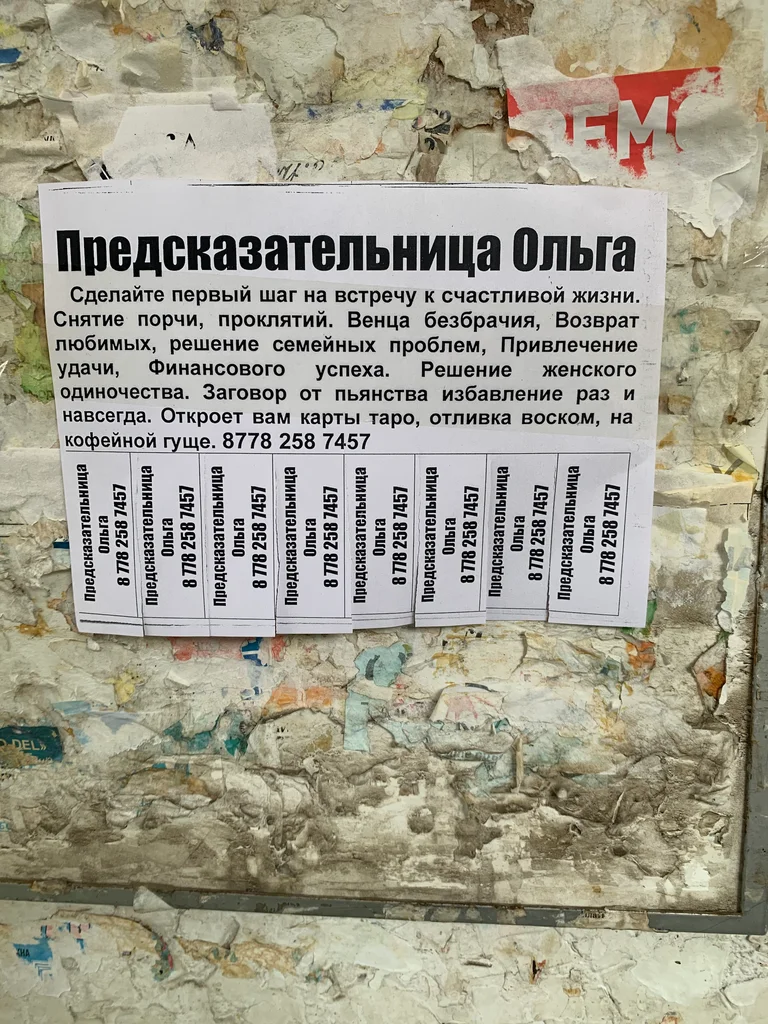
Walking through the blocks of khrushchevki that surround my own apartment building, I always manage to see something unexpected. As someone who grew up out of the city I'm totally addicted to the tenderness and closeness of city life, the million little fleeting moments of connection it provides. It's overwhelming to be so surrounded by humanity. I am aware of how creepy I must seem but I love glancing up at balconies and seeing them lined with houseplants, seeing rugs being hung up to dry as kids chase each other around the courtyard and teenage boys cluster around doner stalls. I love the whistle of a kettle heard through the neighbor's window.
A translation of the flyer: 'Fortune-teller Olga. Take the first step towards a happy life. Removal of ill-wishes, curses. The curse of celibacy, the return of beloveds, solving family problems.
26 July 2024 - Tbilisi
What a beautiful city! A very busy one- a sprawling one- full of people from everywhere, with houses sprawling across the mountains and stretching to the horizon.
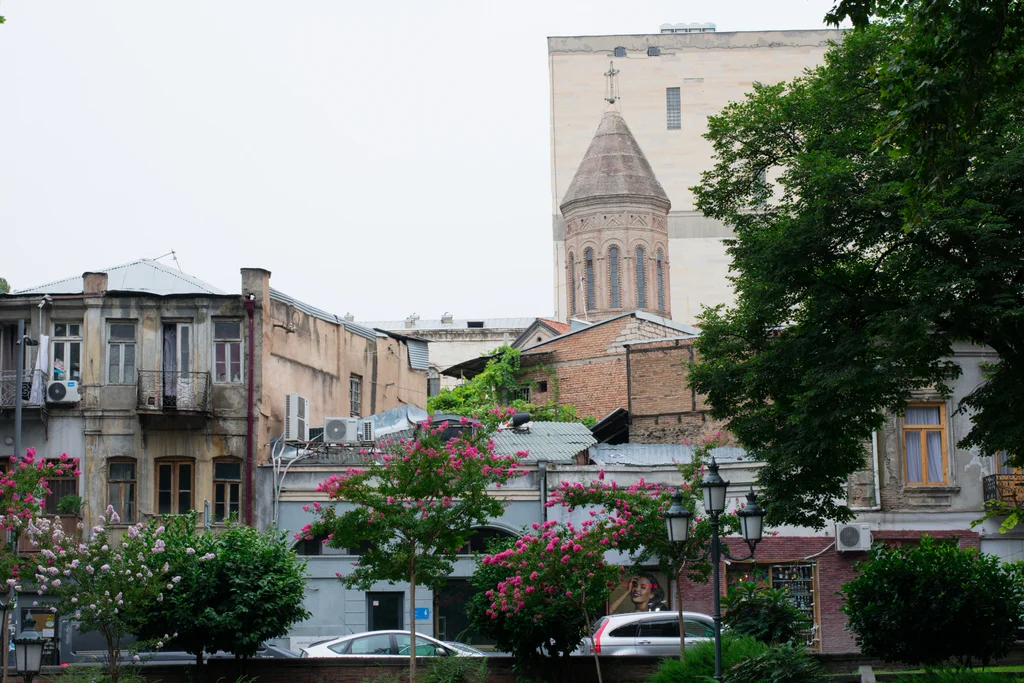
The biggest boulevards are filled with souvenir shops and people hawking boat tours, but there are just as many winding streets that disappear into vines and apartment buildings that seem prehistoric. The doors of the apartment buildings are always open, and through them you can see collapsing staircases, but the lights are on, and kids' legs dange from the balconies.
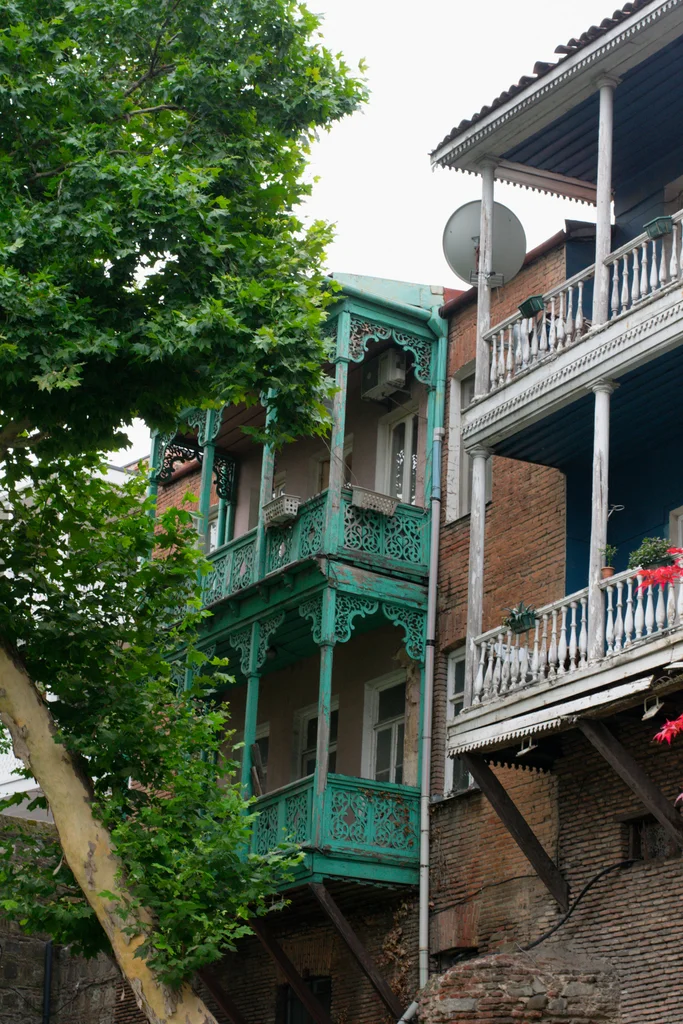
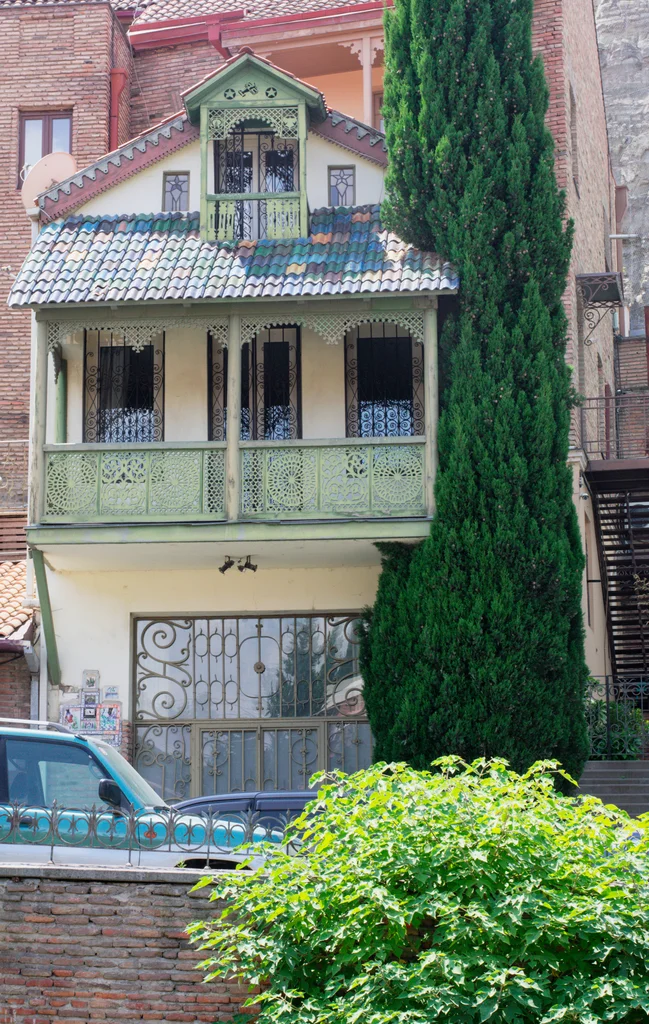
A random encounter to describe it: one evening, we passed one such "abandoned" apartment with open doors and a sign advertising BOOKS inside. Walking up a set of crumbling wooden stairs led me to a balcony overlooking a small courtyard filled with, as advertised, BOOKS, lovingly stacked and ranging from pre-revolutionary publications to guides on the newest English lingo.
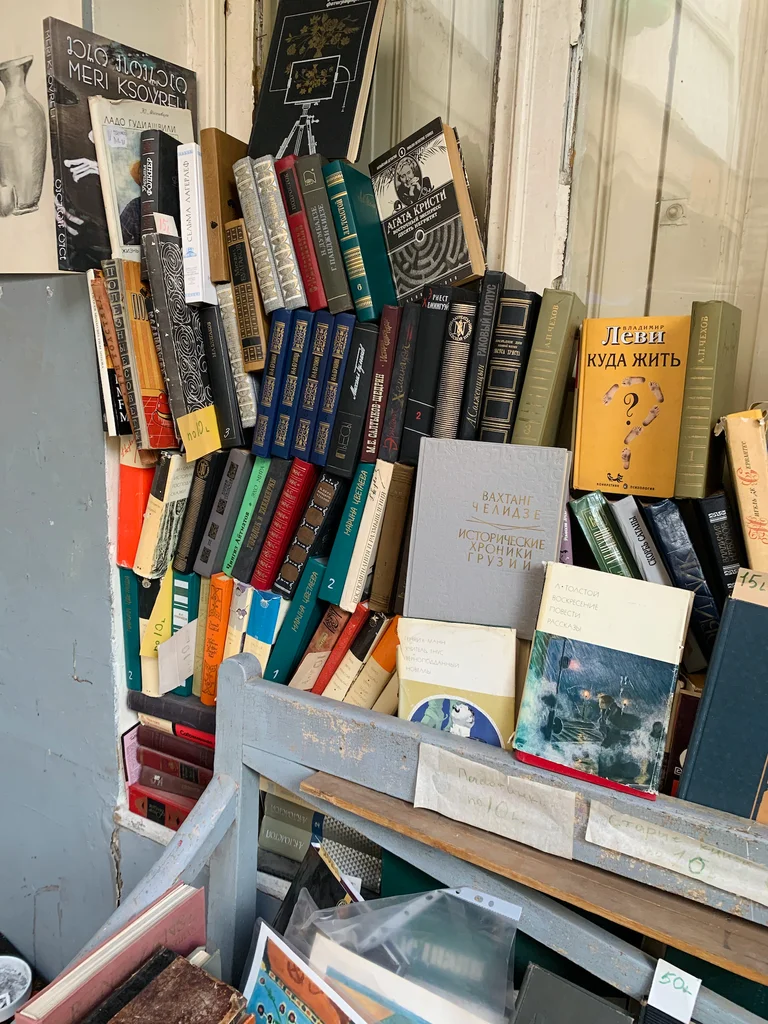
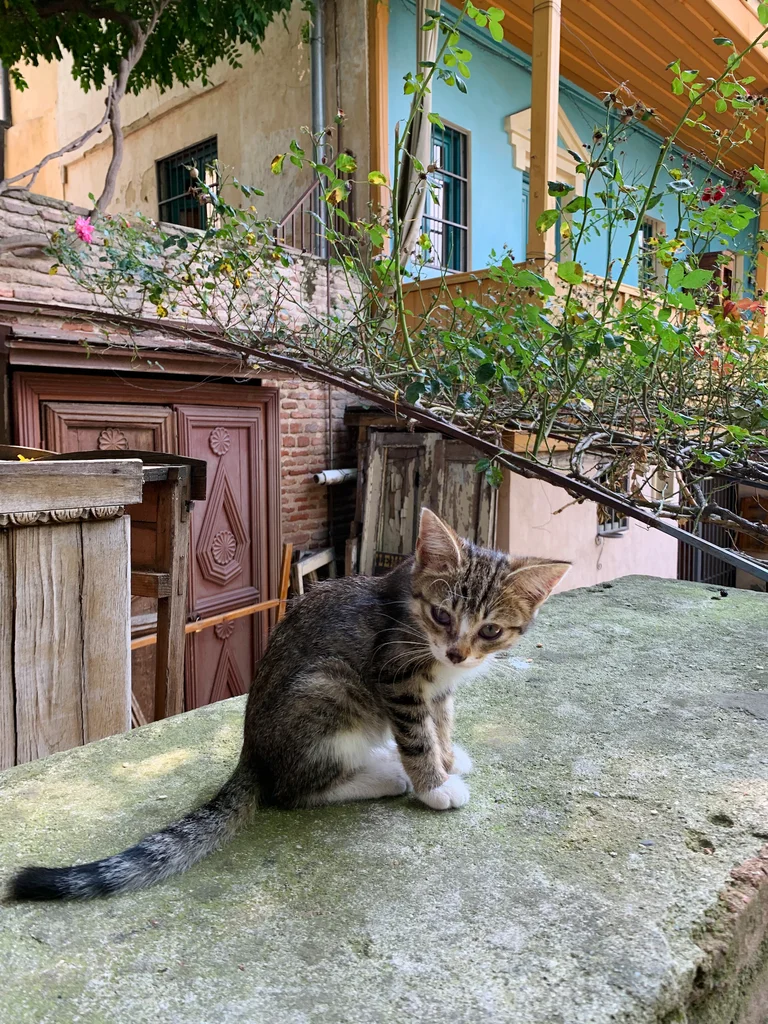
Much like Greece, Tbilisi (and I think probably all of Georgia) is filled with stray cats and dogs, but everyone displays a remarkable kindness towards them- most of them are remarkably plump and turn their nose up at any pity offering of kibble. When we found a grungy-looking dog in the doorway of the place we were staying, the neighbors urged us not to be scared of 'Lima'. I went to a wine store with a remarkably friendly cat who the owner told me showed up five years ago and decided that it would be her kingdom.
20 July 2024 - Drainage pipe flowers
I spent two nights in Baku and finally landed in Tbilisi this morning.
Baku is a strange city. Outside of its oldest part, its frantic energy reminds me a lot of Bishkek and Almaty. Things are constantly being built and destroyed (I was ushered into one restaurant by an owner holding a wet paintbrush, nails and drywall dust covering the floor). The horizon is taken up by bizarre buildings that seem to serve only to prove wealth and power. From my American viewpoint it's probably easy to place it and Kazakhstan in the same box as 'oil autocracies' - hell, aparently Aliyev and Nazarbayev were good friends - but that seems a little simplistic. Obviously my disgust with the current regime in Azerbaijan colors my perception of it. You see ghosts everywhere - the carpet museum is particularly insidious.
A small thing: many air conditioning units drain into little potted plants on the sidewalk. I've never noticed this anywhere else, but it's genius.
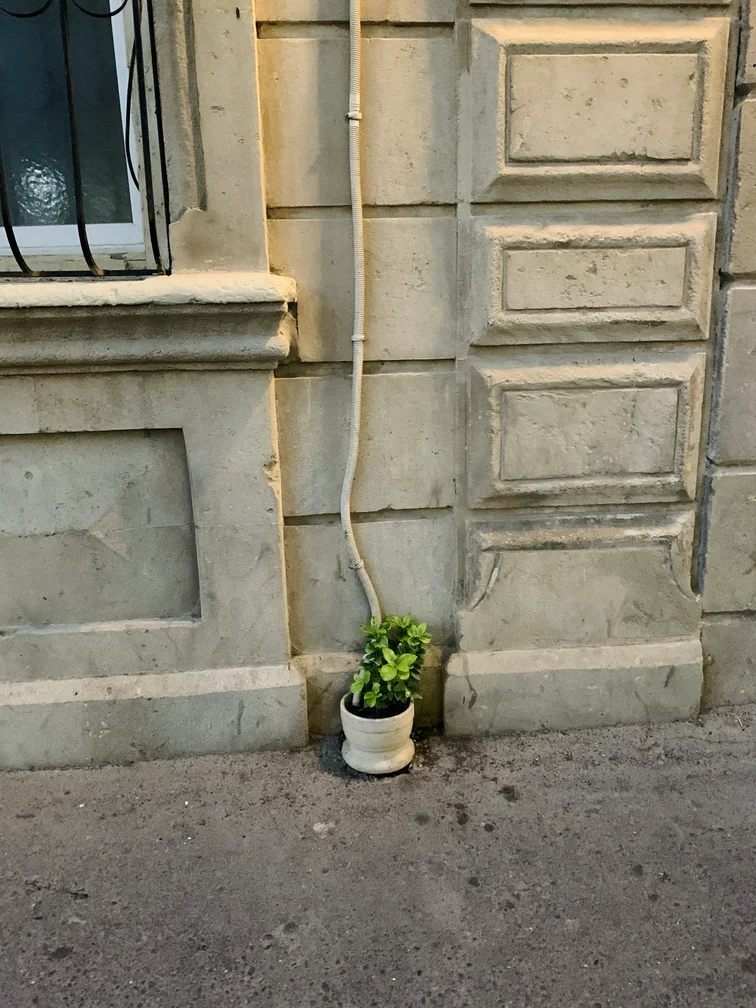
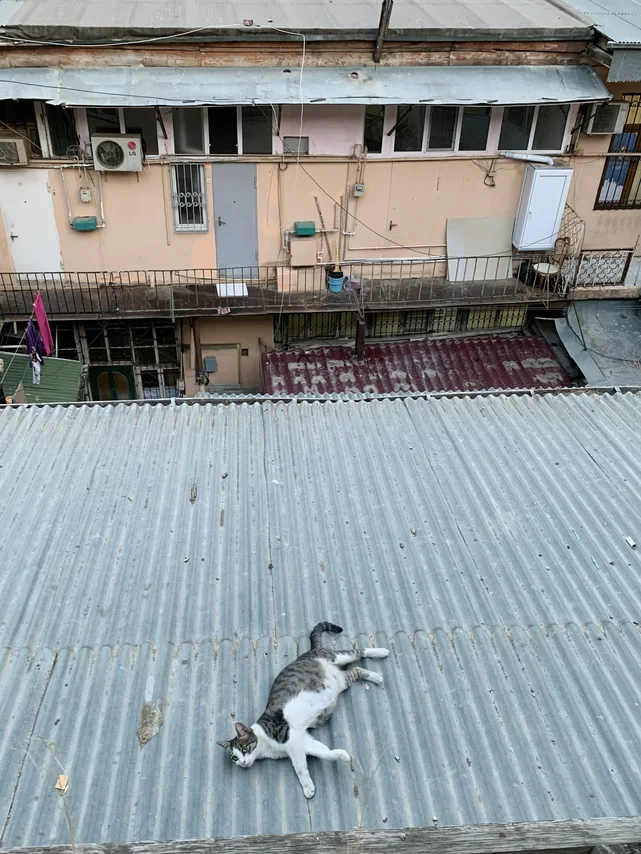
17/18 July 2024 - Baku Airport, 12 AM
The Baku airport is an unsettling glass prism with more technologically advanced doors than I'd seen in my life. I'm waiting for my visa while I type this and completely failed to communicate to a officer whether I was breaking any diplomatic rules by crossing through some gates to get to the only bathroom between the tarmac and the visa checkpoint.
The design philosophies of airports remain very interesting to me; they feel like spaces where the impact of architecture on psychology is especially palpable. The Tallinn and Riga airports are nice. The San Francisco airport has a cool train (I love it!). The Portland (ME) airport lets you carry on live lobsters.
I have been in many airports recently. I flew to Tallinn, which a friend called a snowglobe - I think it's an incredibly apt description. It's truly beautiful, yet so manicured that it becomes a little eerie. There are a lot of people on the streets LARPing as medieval tavern-owners, monks, and nuns. It doesn't give you the impression that you're passing back in time, but rather than you've stepped onto the set of a very high-budget theater production. The parts of Tallinn outside of the Old Town feel much more real and lived-in, beyond setpieces.
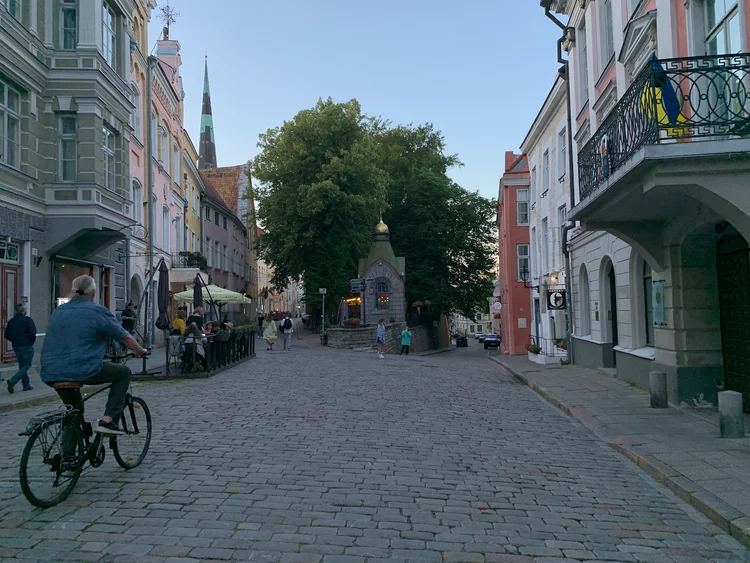
Riga's old town, in comparison, feels less enclosed in glass.
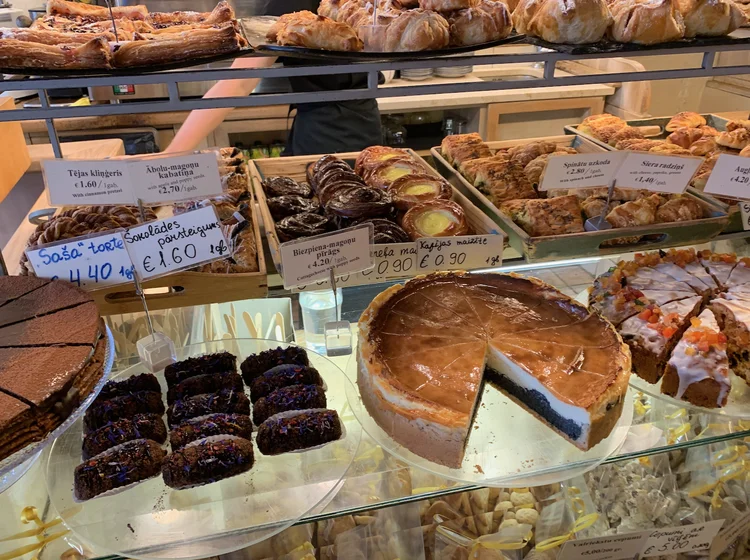
I love combinations of flavors I wouldn't have thought of before and breakfast pastries that go beyond croissants, so I fell in love this bakery. Poppy seed and cottage cheese cake, a mysterious "šokolādes pārsteigums" (chocolate surprise), and a "ābolu-magoņu kabatiņa" (apple-poppy pocket)... also a lot of sweet things incorporating rhubarb, my favorite "fruit". (I saw rhubarb incorporated into everything in all three Baltic states, much to my delight!)
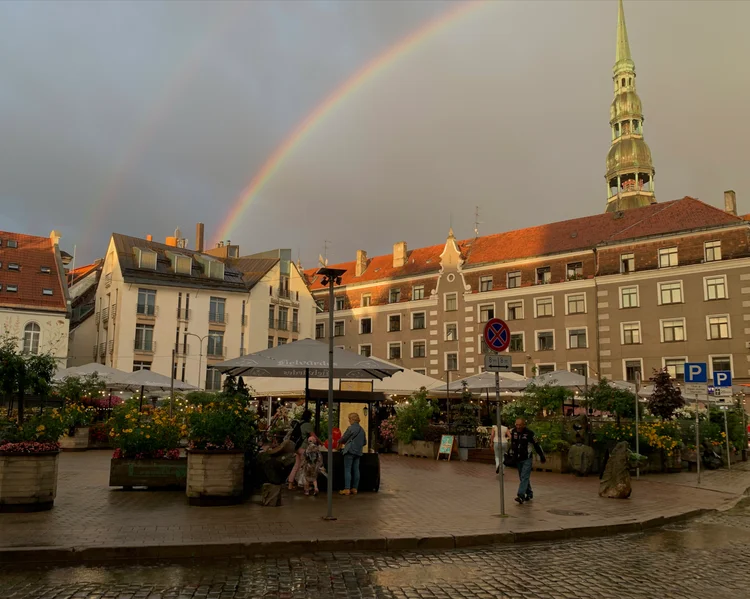
On my first night in Riga while eating outside it started to absolutely pour rain. When the rain ended, I stepped out to see one of the most beautiful rainbows of my life.
I also loved the central market in Riga; it reminded me a lot of Almaty's Green Bazaar, with the same eclectic collection of preserves, pickles, and gaudy clothing.
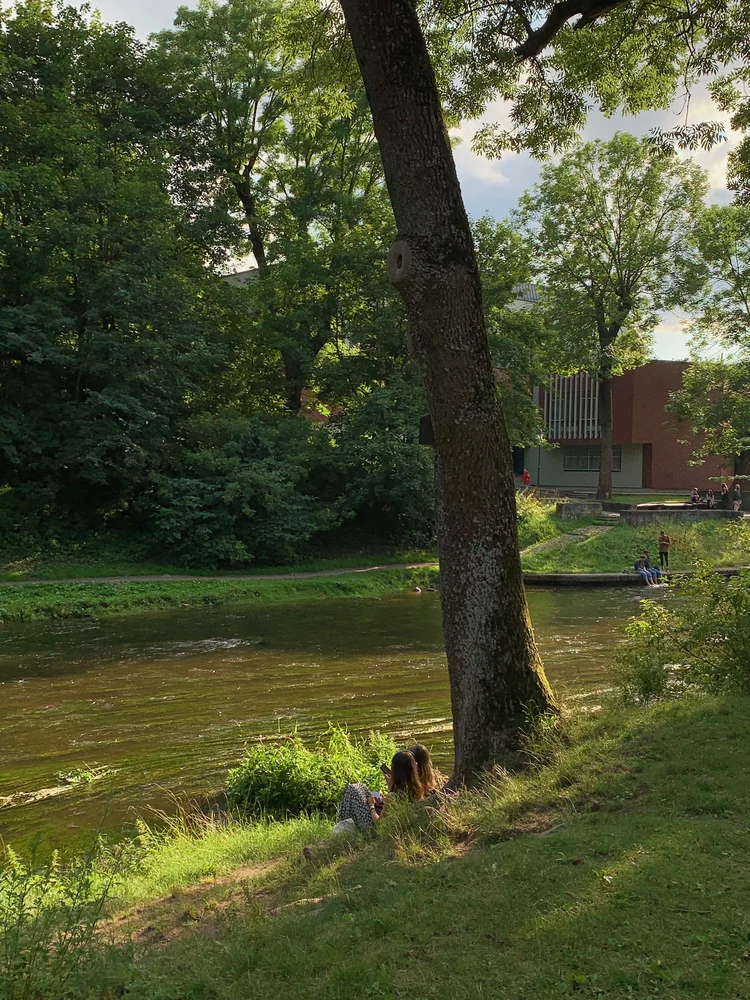
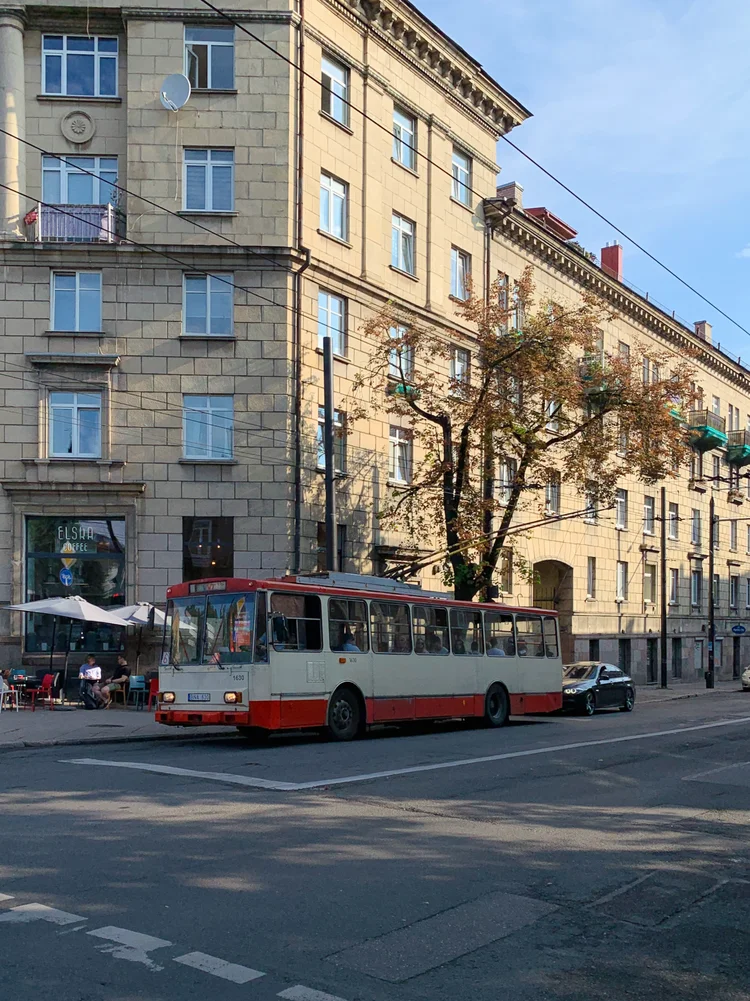
My favorite thing in Vilnius must be the Bernardine Garden. It was beautiful to laze around on a hot summer day and watch people with tiny stupid-looking dogs stroll by.
The ice cream is also very good. My traveling companions were totally baffled by the existence of a "milk" ice cream flavor. I would love to know how vanilla became the default blank slate for ice cream in the United States.
I hope I get my visa soon... my legs are starting to hurt in this chair. They took my passport, too.
9 July 2024 - Normal Animal
Yesterday an older woman was buying five bags of marshmallows at work. I asked her what her plans were for them, and to my surprise she answered that a family of raccoons visits her every night, and they've been bringing more and more friends lately. To quote her, "it's cheaper than having a dog".
Some of my favorite animals are the pests and annoyances of suburban life, and one such favorite is the squirrel. If you watch them, you'll notice that they're extremely cute and charming little things. I have even recently succeeded in getting one to eat out of my palm!
I present thus a squirrel who was posing for me this morning.


24 June 2024 - Sonoma Coast
I've been in California for the past few days visiting family. I haven't been out to the west coast for probably over a decade, and it surprised me how different the flora and fauna are from what I'm used to... I saw what I guess was a gopher and was totally stunned by it. I could only describe it as "something that looked like a squirrel but certainly wasn't".
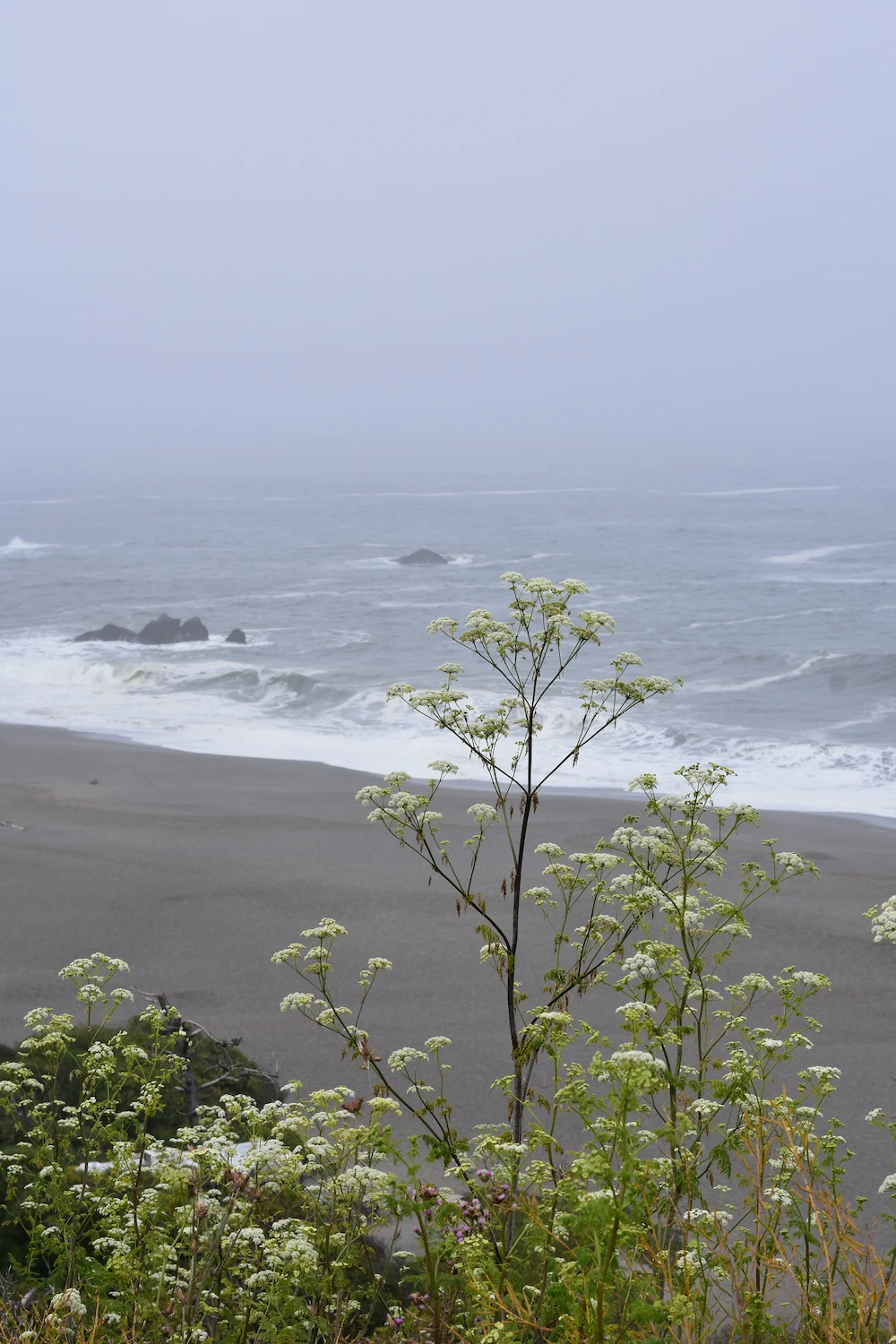
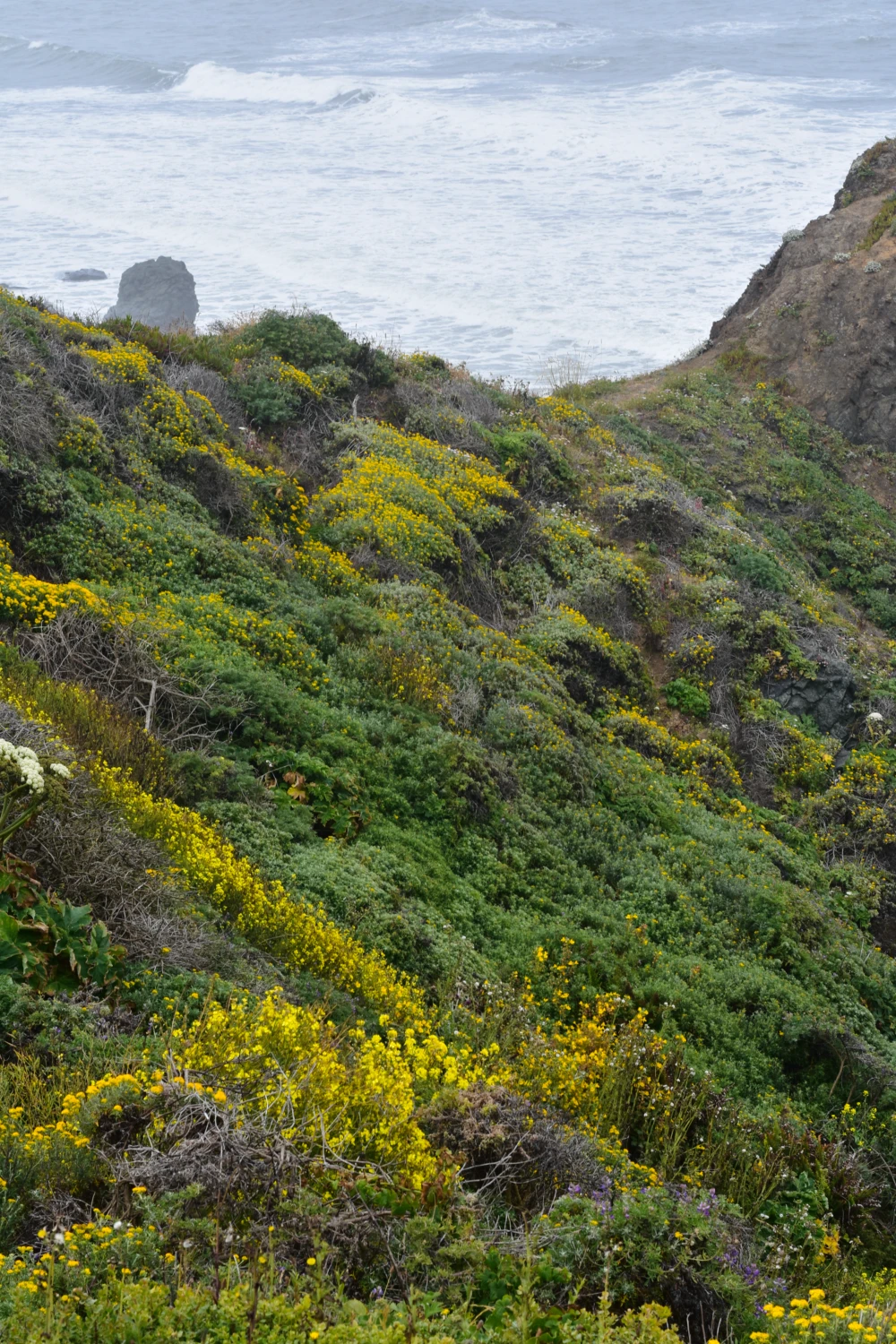
The coast is stunningly beautiful, with the fog and hills and carpets of wildflowers. It reminded me almost of Ireland, like around County Kerry, but it looks a lot different too. I was particularly entranced by the massive chunks of driftwood- from redwoods?- on the shore, they look like the bones of some massive sea creature washed up and left to bleach.
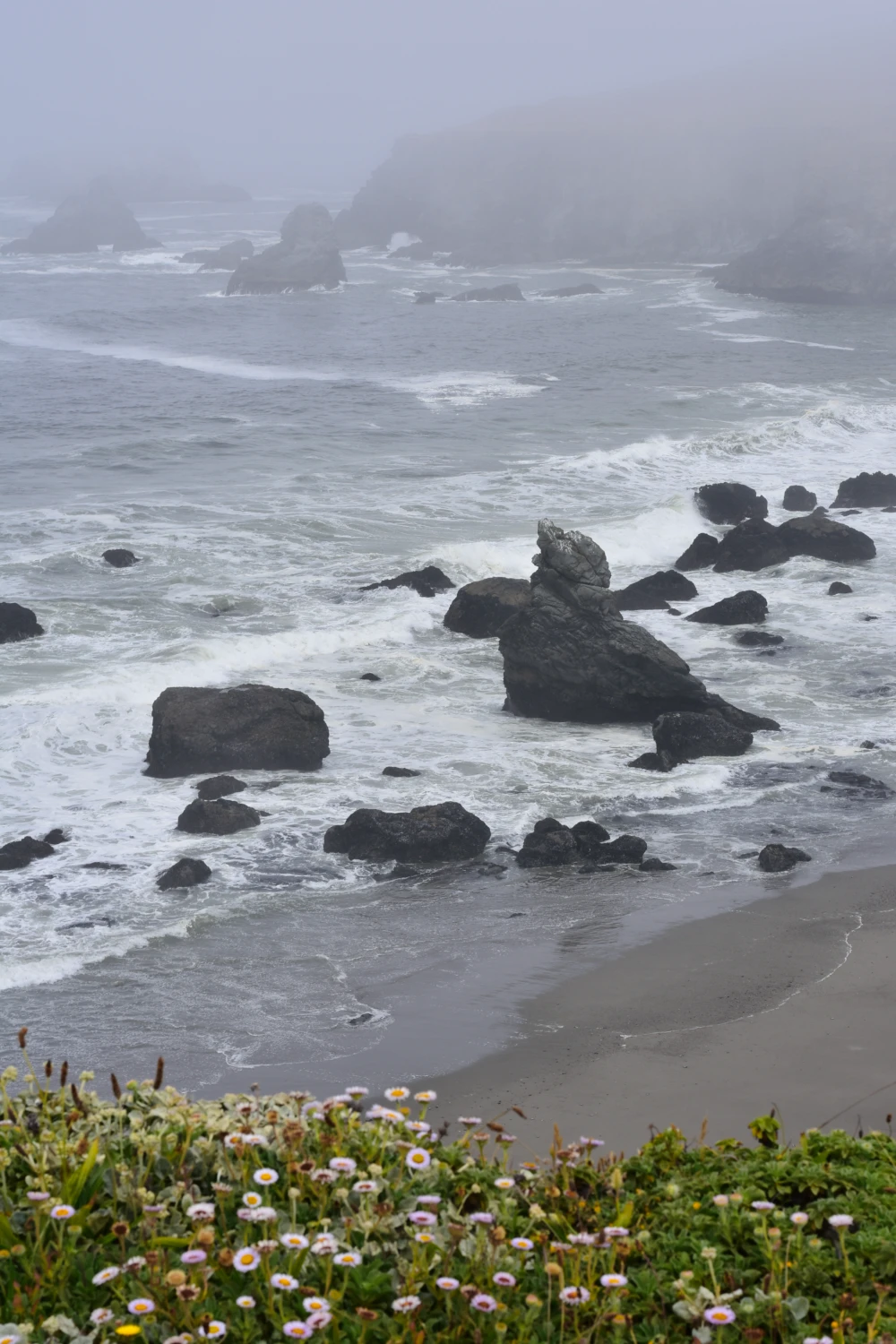
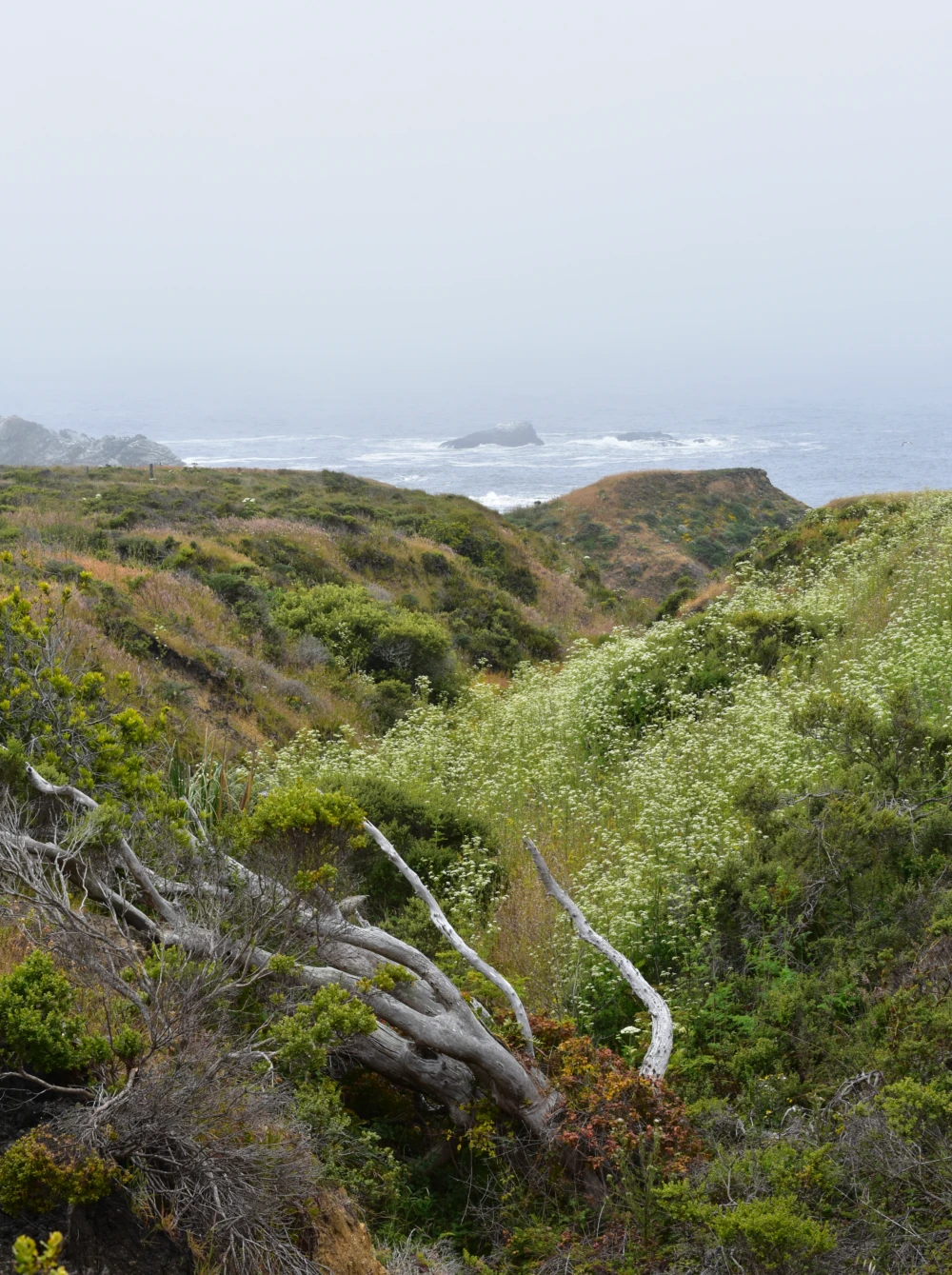
I spent a lot of time with my camera pointed at the ground. The complexity of texture and color in a little patch of ground can be so remarkable. I have been in a plant-y mood and got angry and frustrated when I saw all of the beautiful orchids they were selling at the farmer's market, which I obviously can't bring back on the plane (unless...?)
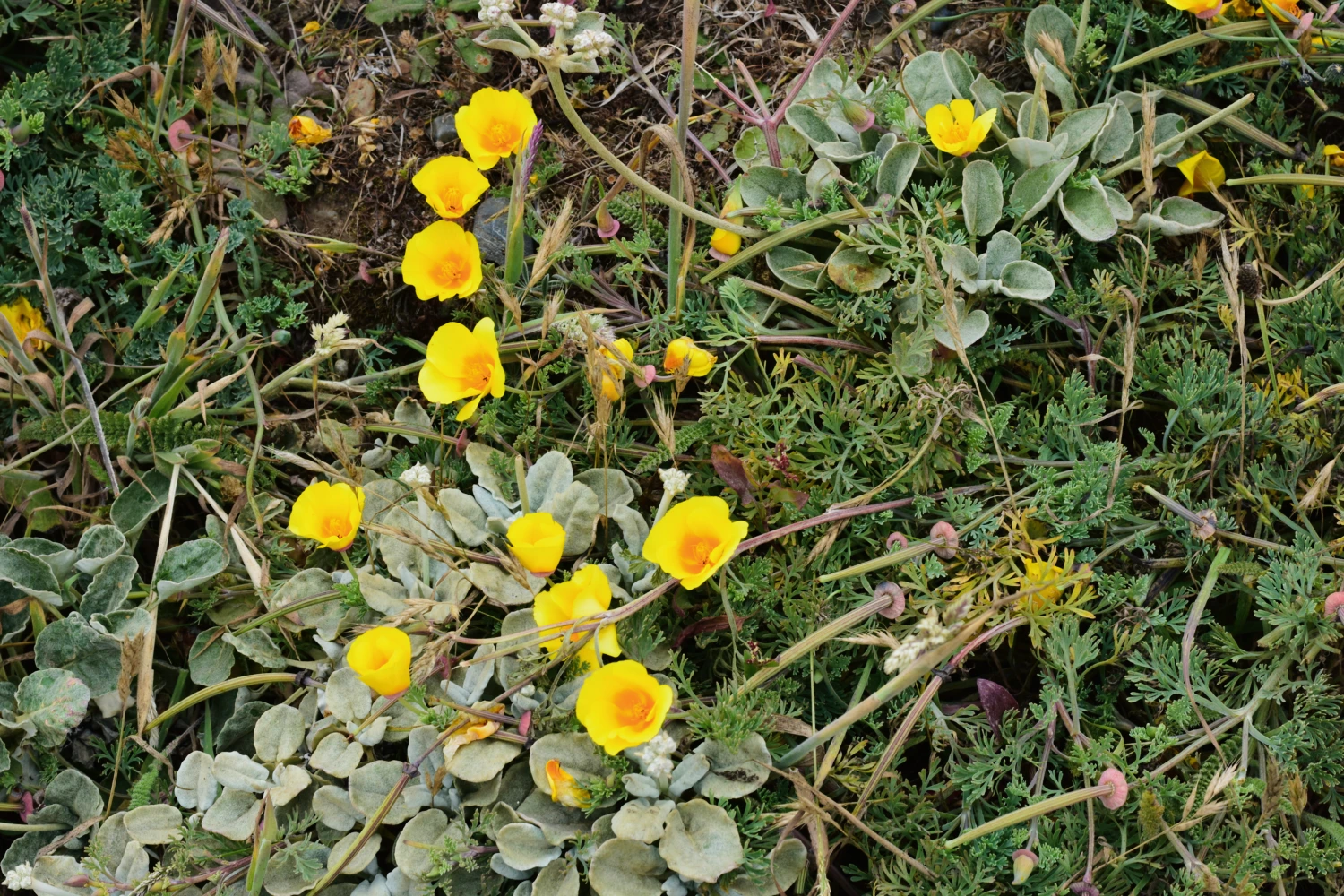
21 June 2024 - First post, rhubarb, and chicken-of-the-woods
The earliest treasure of summer, for me, is rhubarb. I adore it, and I can happily eat it raw, but I'm just as happy to cook it down with some sugar and layer it over ice cream, or make into a sorbet, or add it to a crumble or pie. A customer at work remarked to me that rhubarb (and fiddleheads) are one of the few remaining true seasonal delights in a world where every fruit must be available all year round, be it imported from Mexico or grown in a hothouse. You can have strawberries or apples, albeit subpar ones, all year round, but try finding rhubarb in December!
Anyways, I filled up my backpack with rhubarb from work and biked home. I couldn't zip it shut so the stalks waved around and I had an acute sense that everyone I passed was laughing at me.
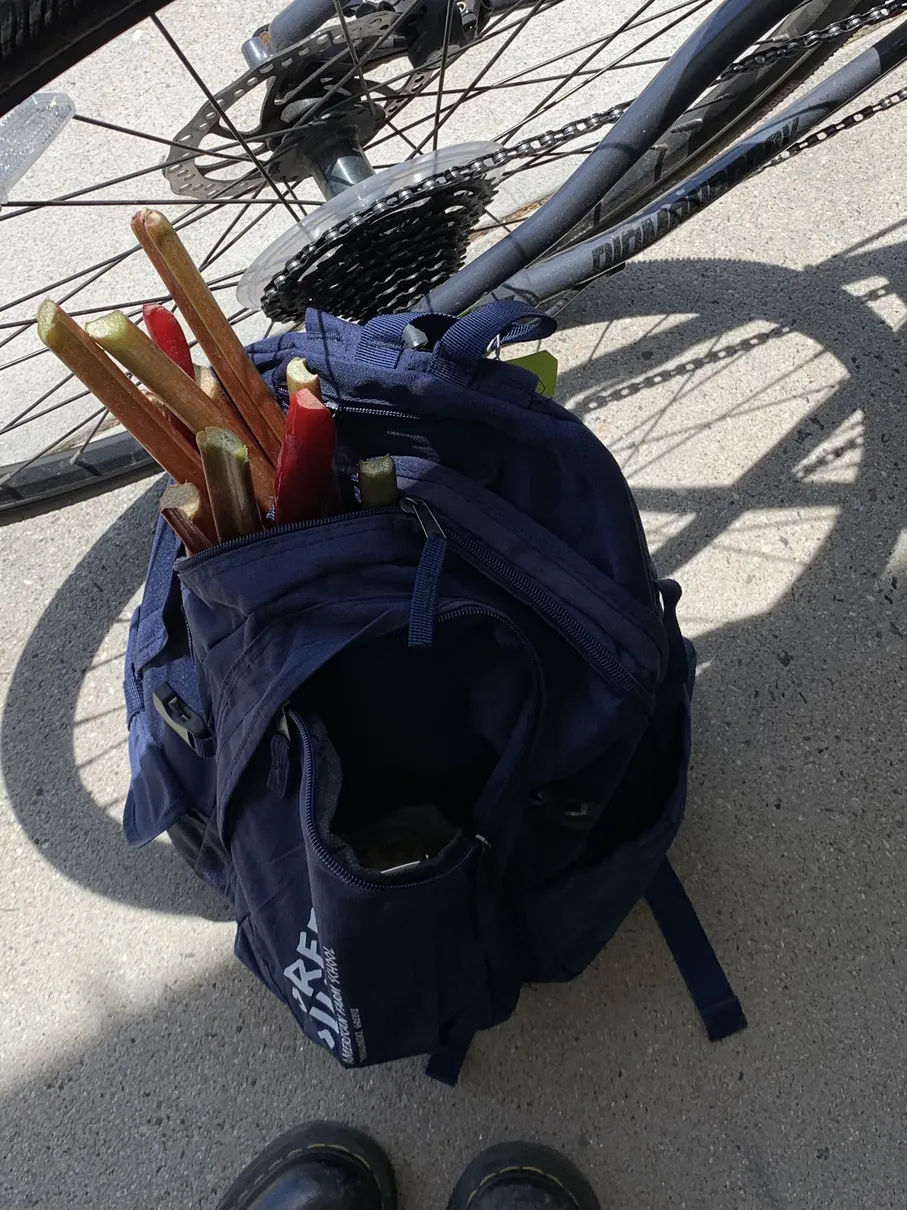
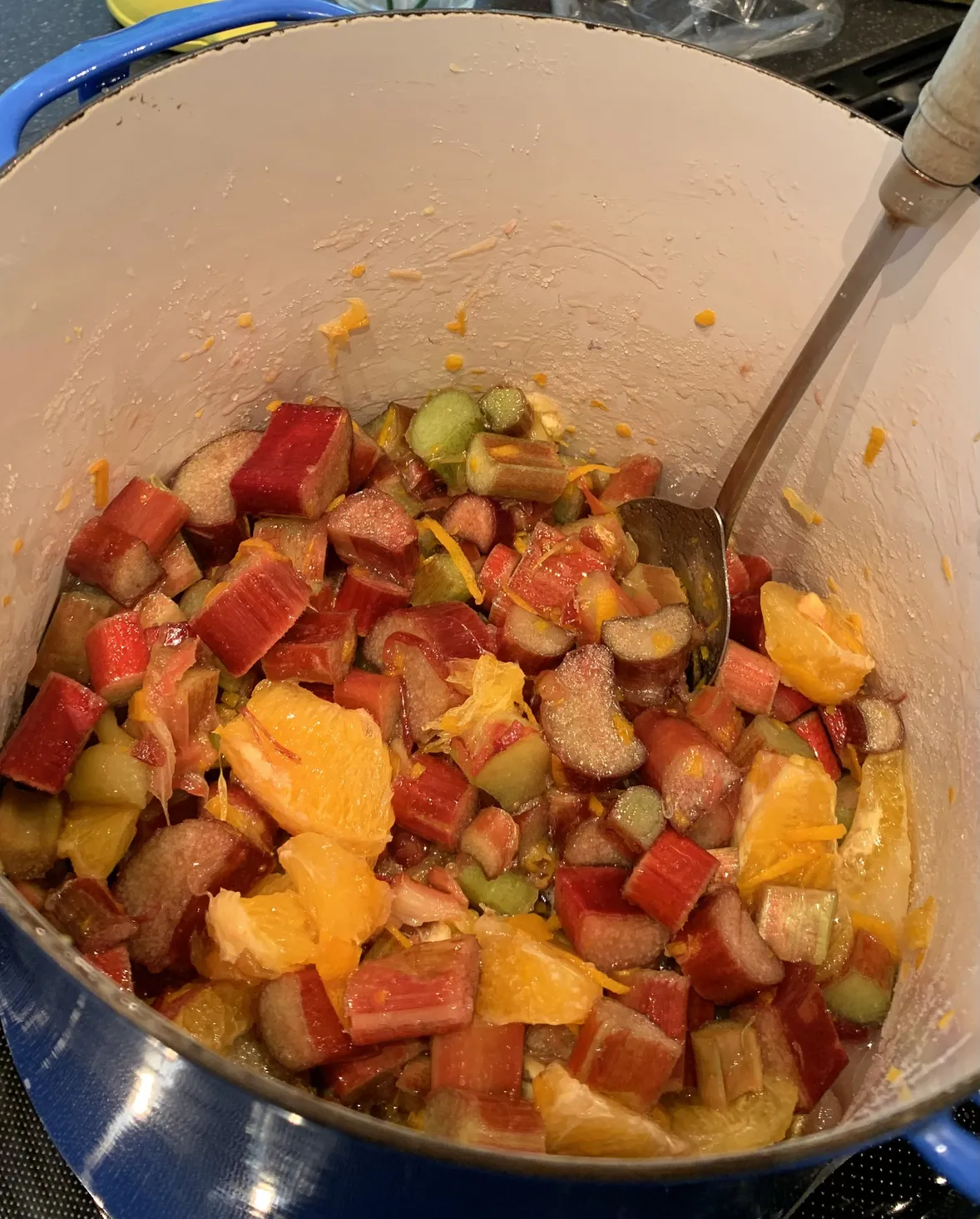
This time I decided to make a jam in hope of sharing the taste with a few friends who lived in places where rhubarb doesn't grow. I followed a recipe for a rhubarb and orange jam and added a lot of ginger on a whim- I have nothing against strawberry and rhubarb but I think strawberry tends to overpower rhubarb rather than let it stand on its own.
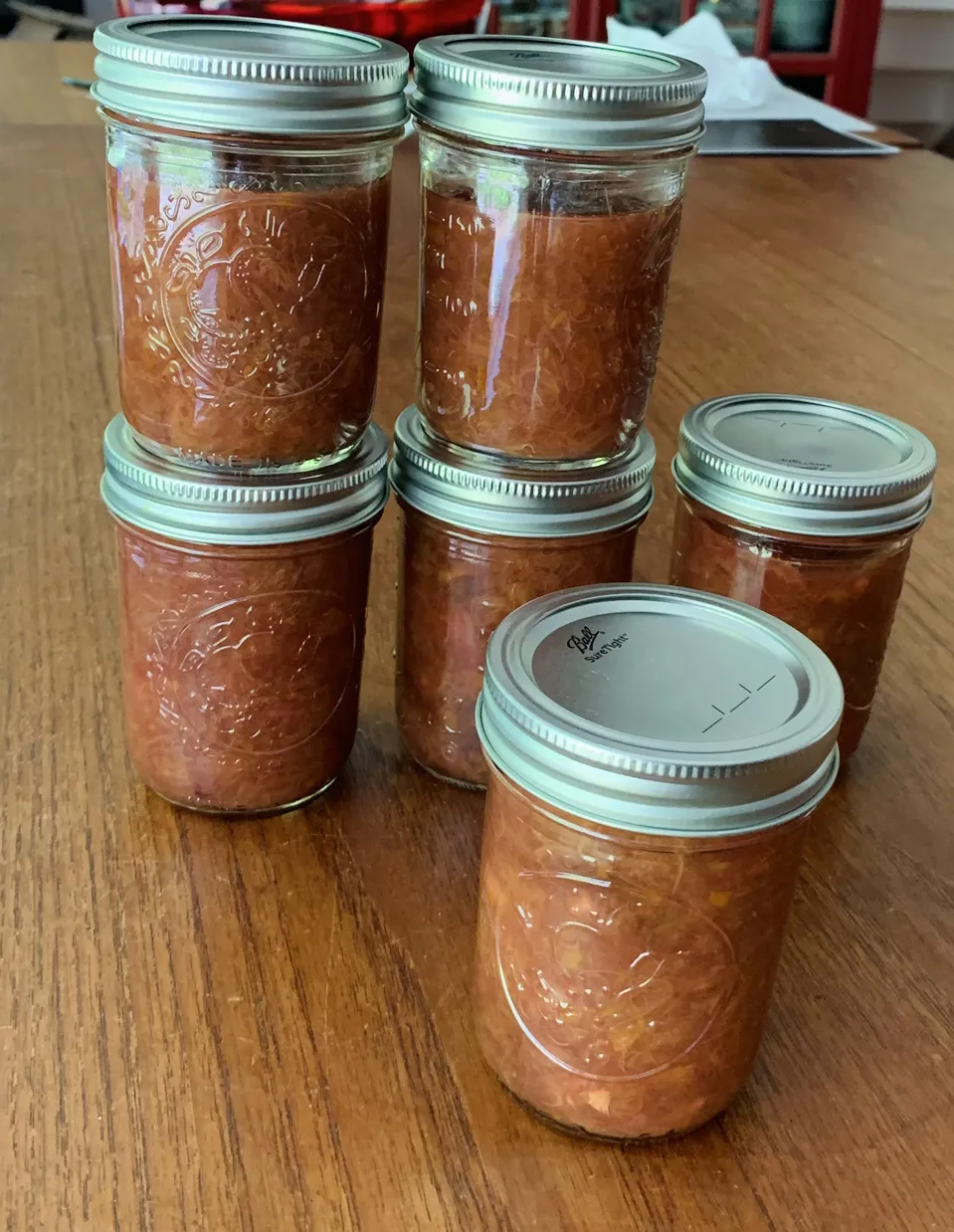
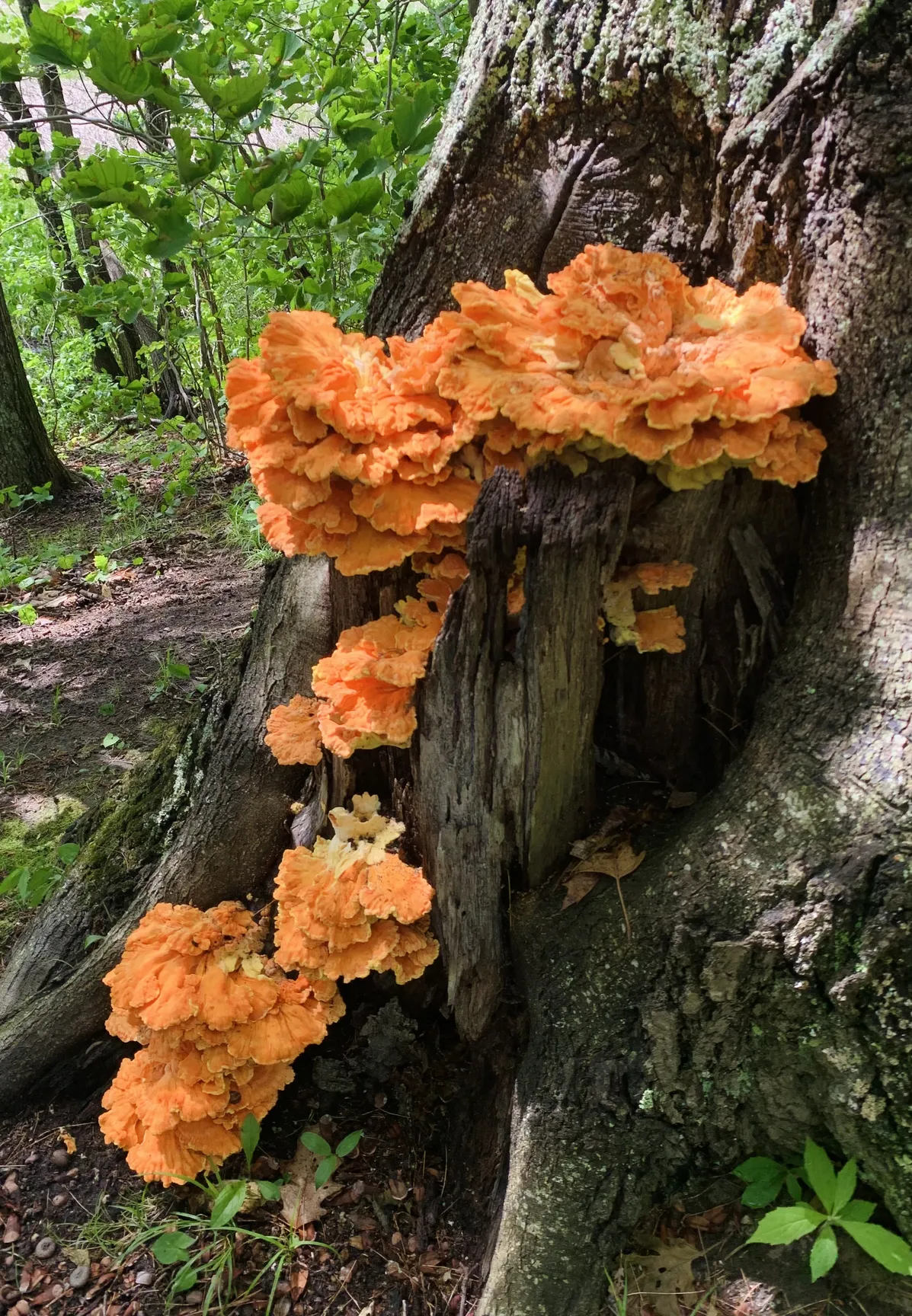
For my first jam-making attempt I was quite happy with the fact that I was able to make anything at all. I've been eating it on toast, with yogurt, and with ice cream... it presents many possibilities :-)
-
I've attended mushroom forrays with a local mycological society, but I have never foraged and cooked mushrooms on my own out of a lack of confidence in my own inability to not be stupid (that is, my stupidity). I recently stumbled across a tree (that one ^) properly overflowing with chicken-of-the-woods, though, which I have heard is a safe bet not mistaken for anything else.
I grabbed a chunk and sauteéd it with white wine, salt, and pepper, then had it with risotto. It's very good! The taste of the mushroom itself isn't as notable as its meaty texture (hence the name- though I think the similarly-named hen-of-the-woods is named after its appearence, and not its taste).
